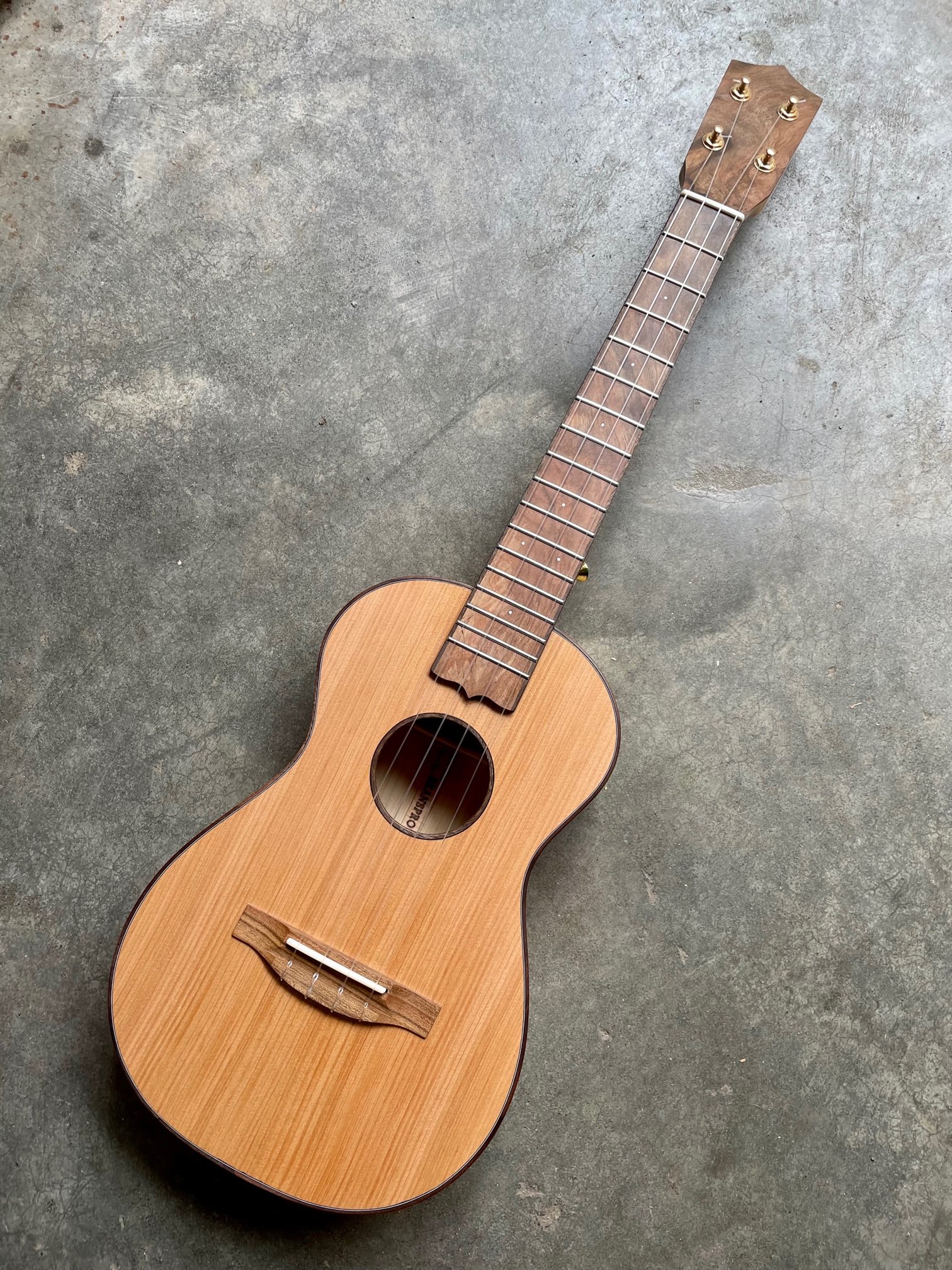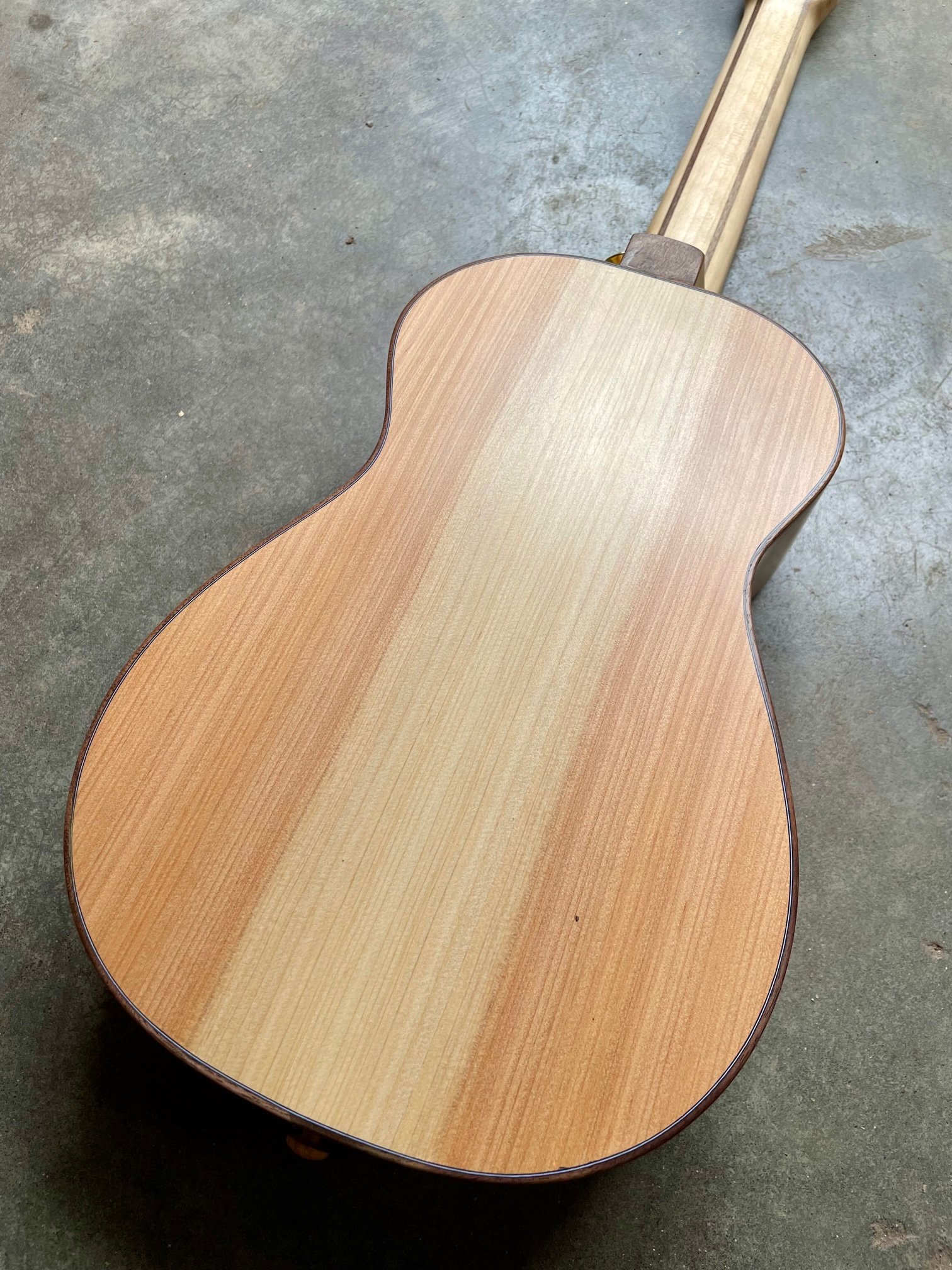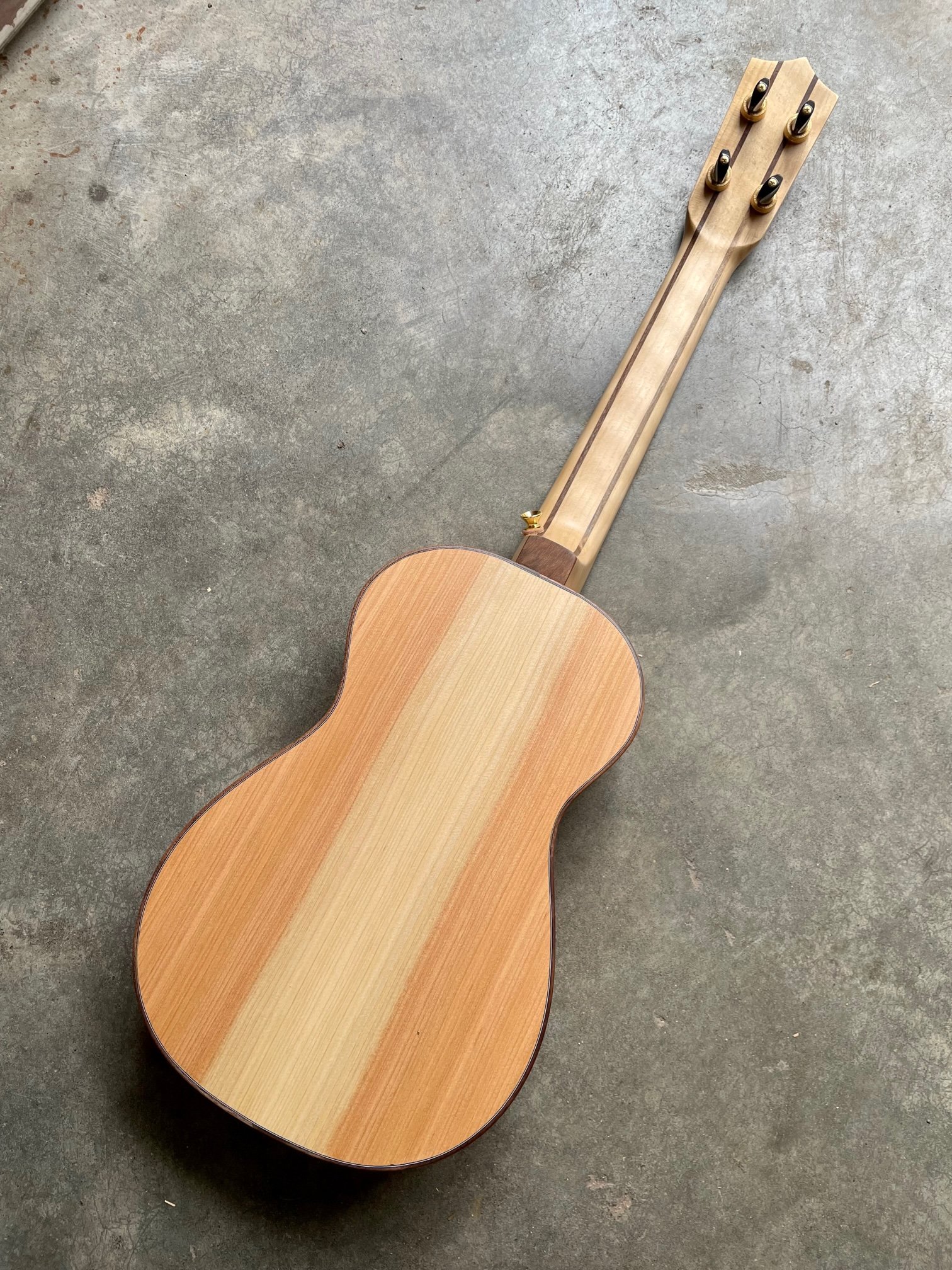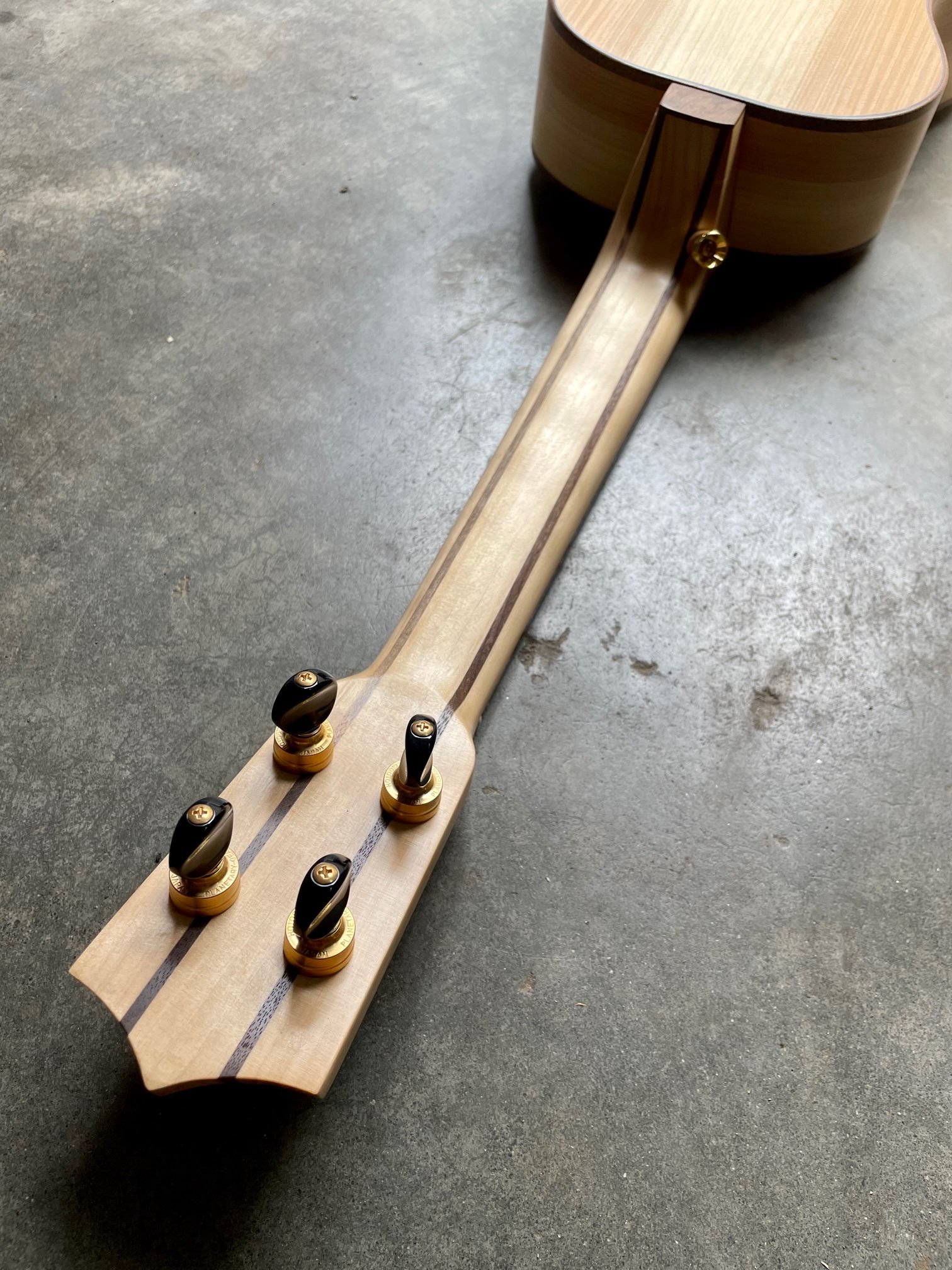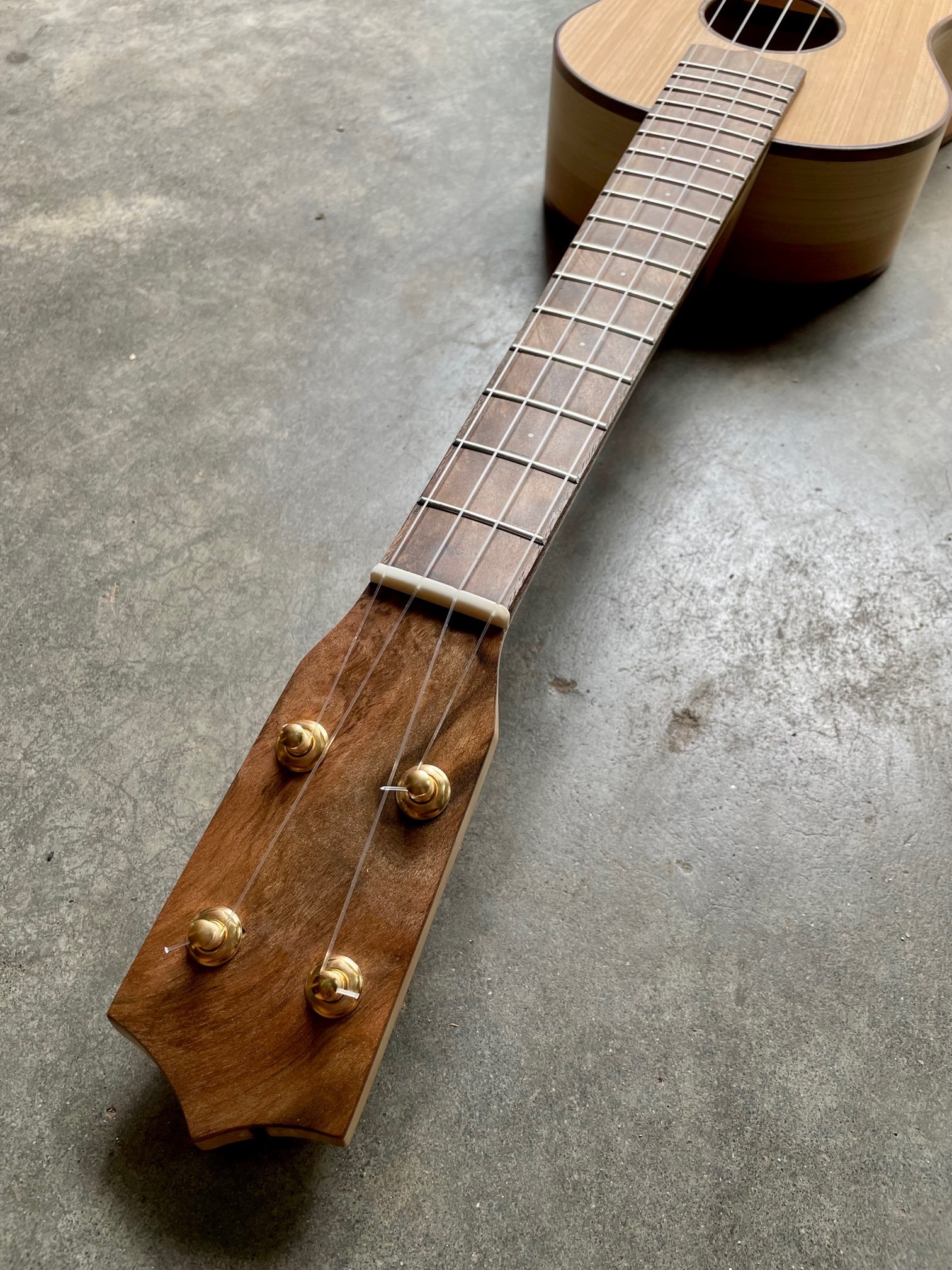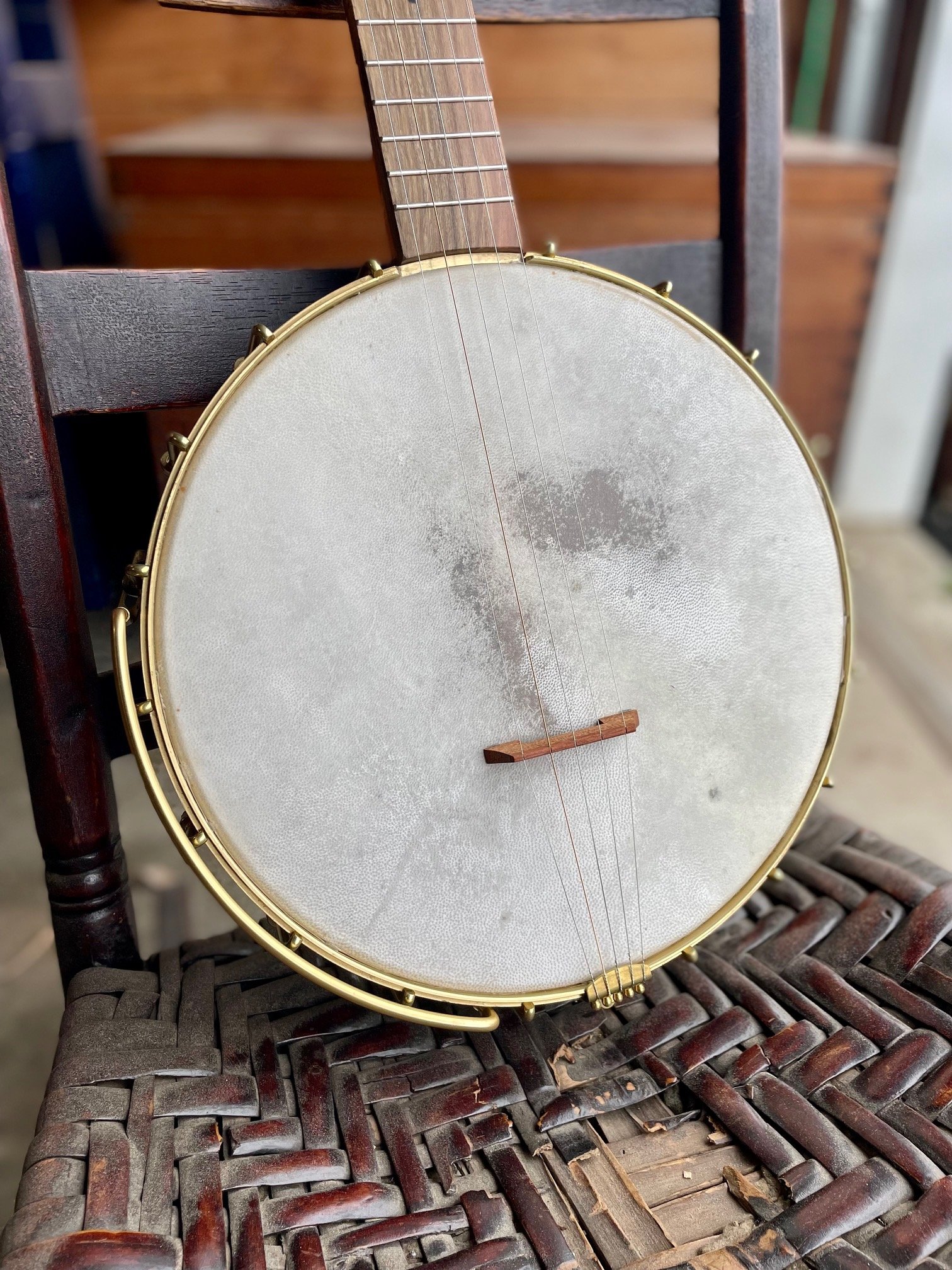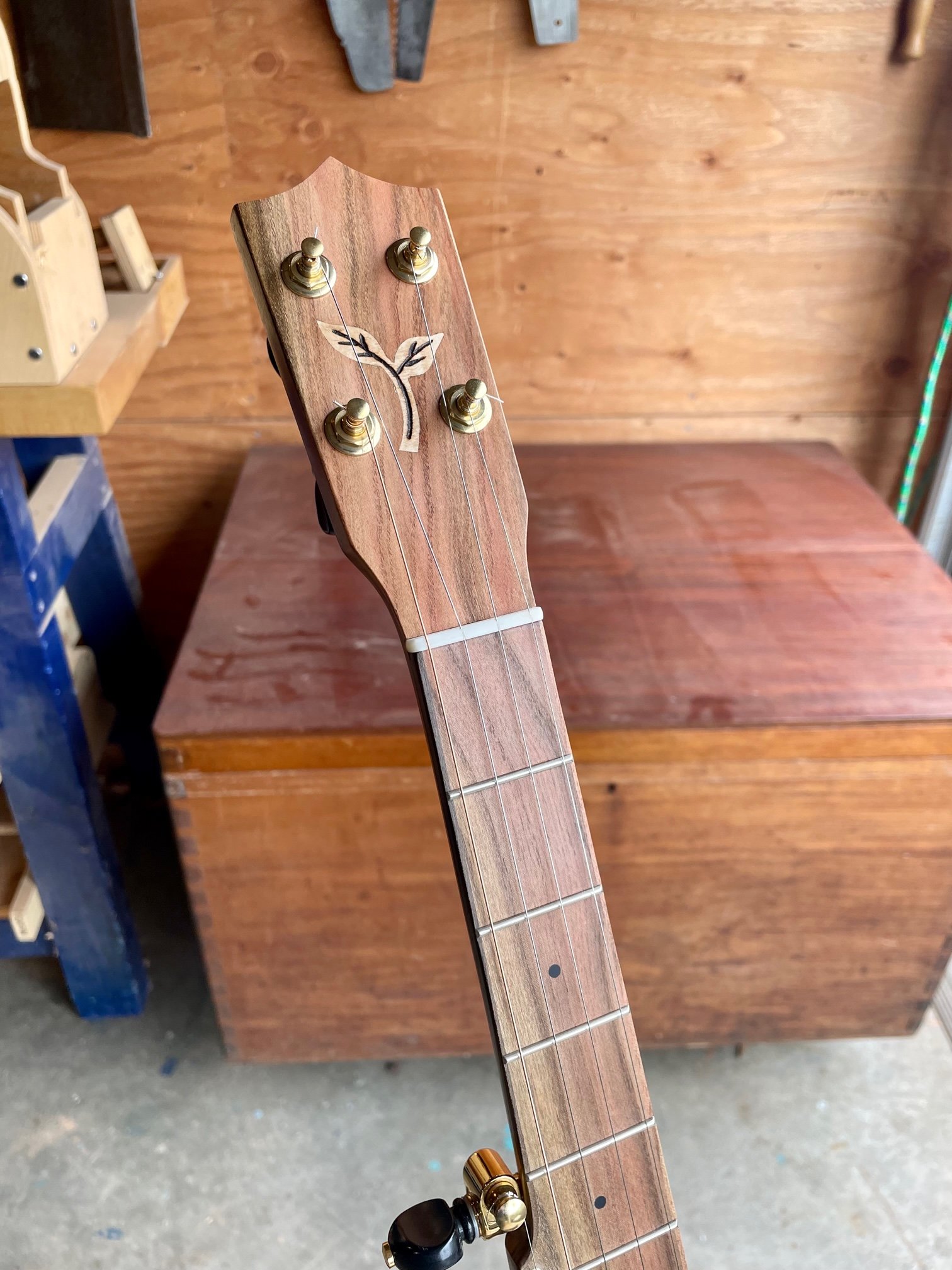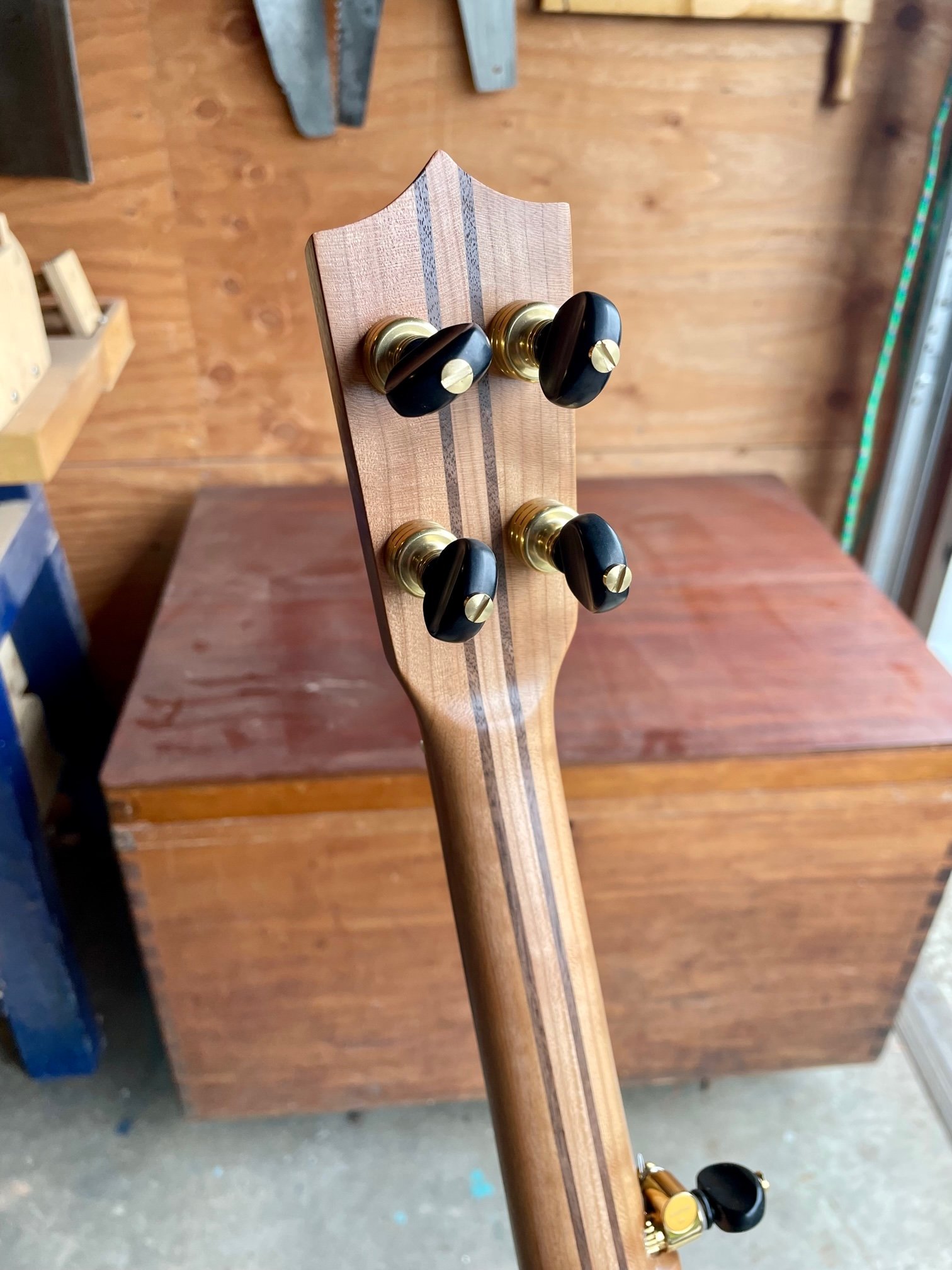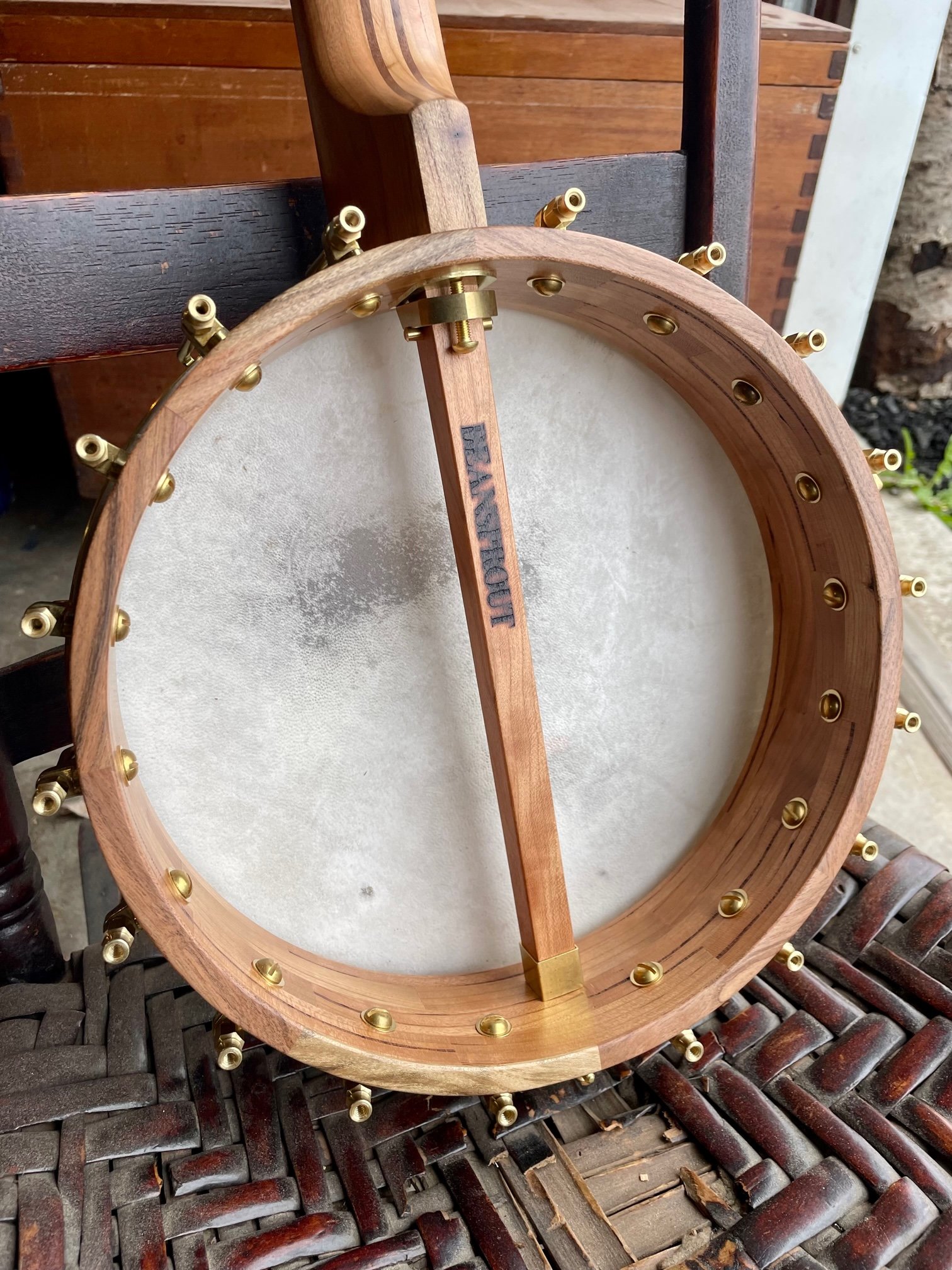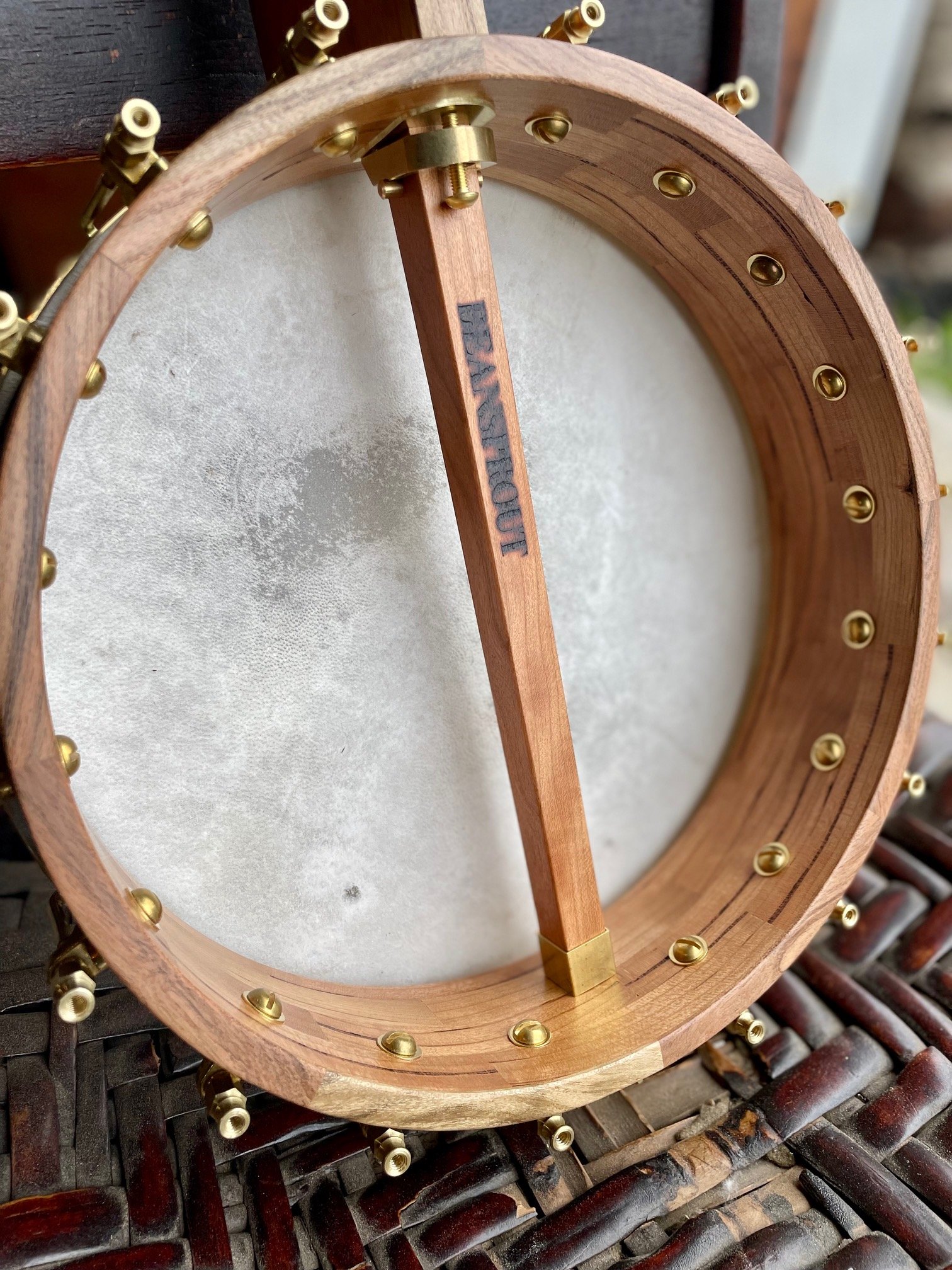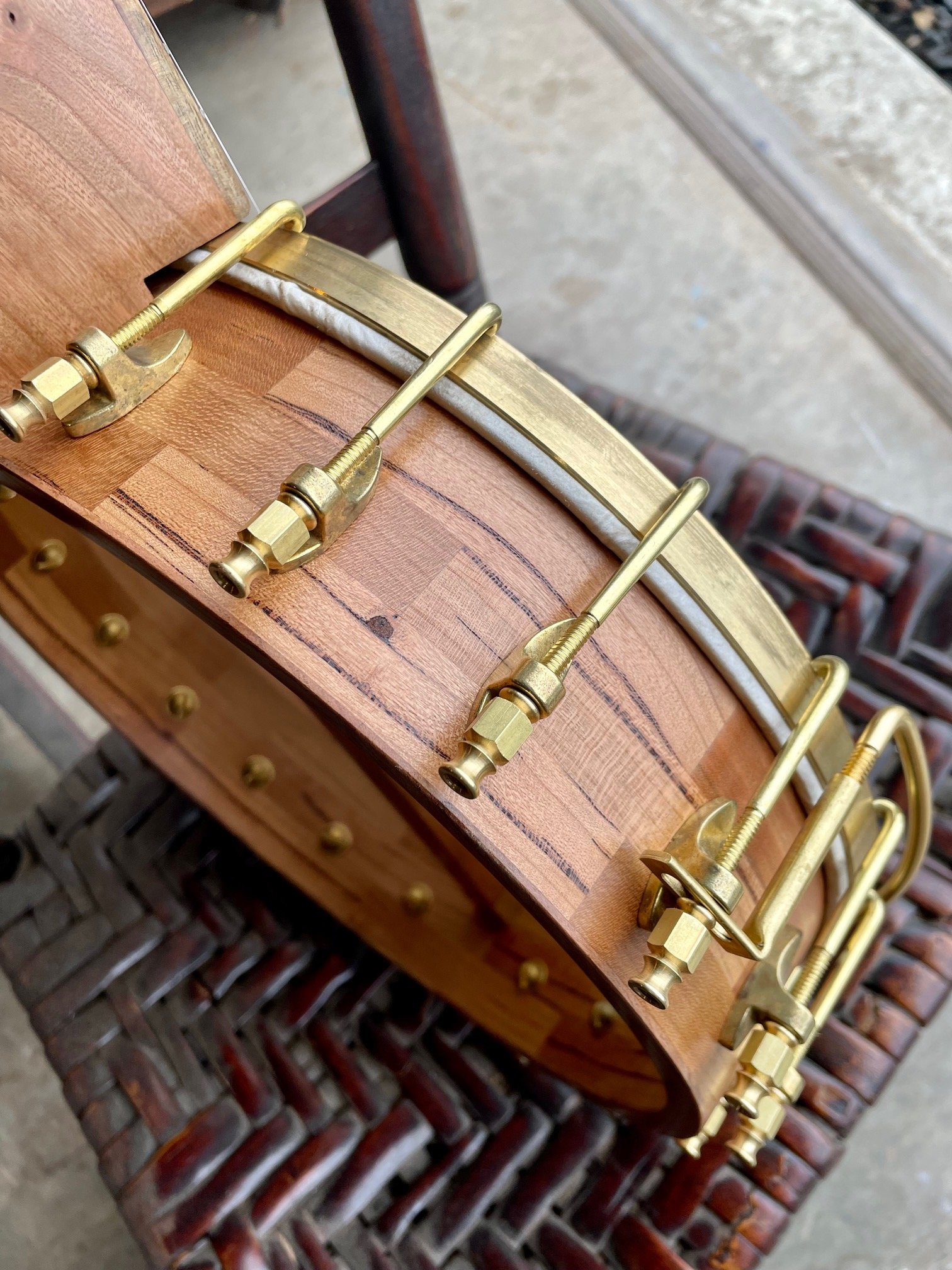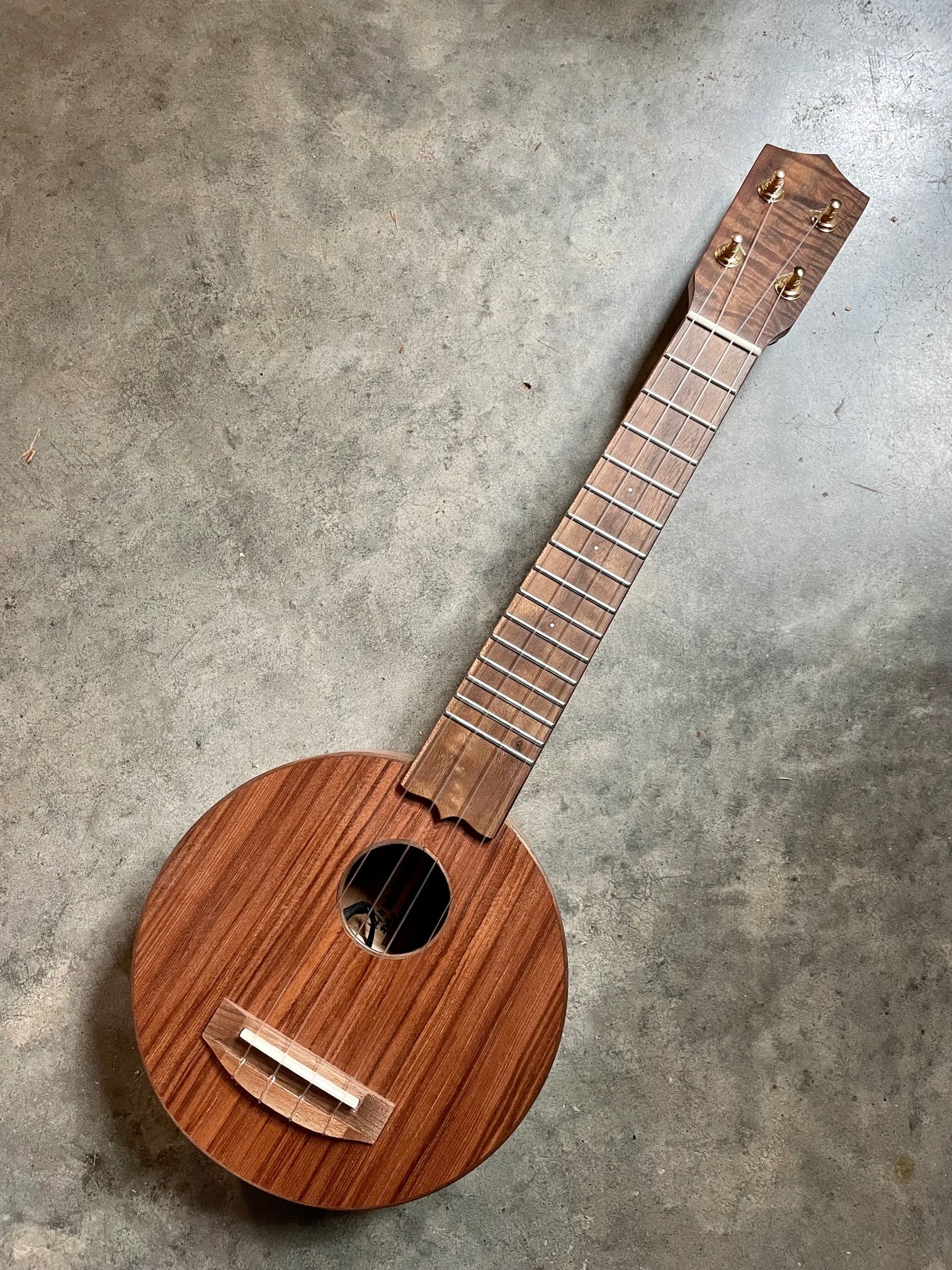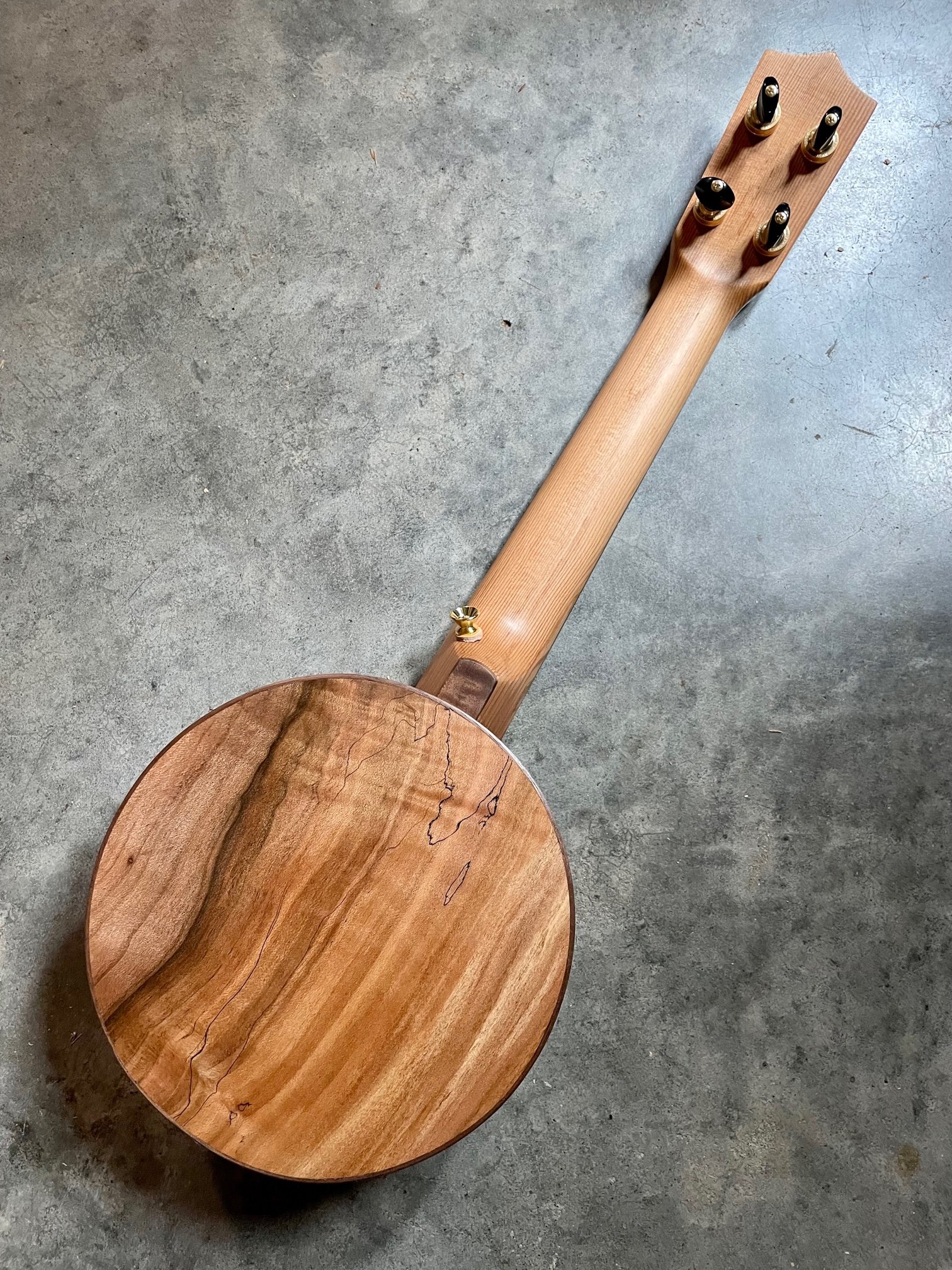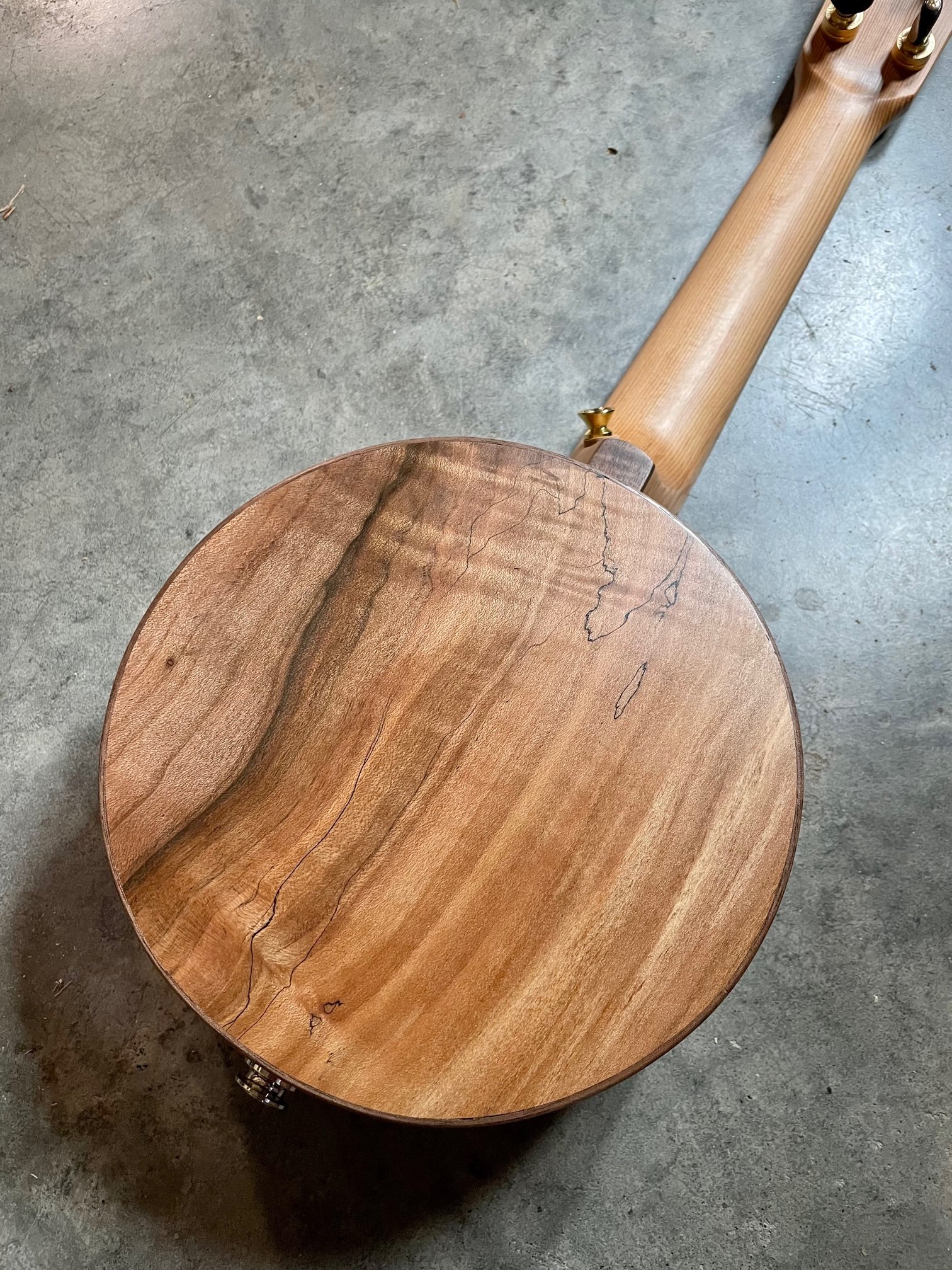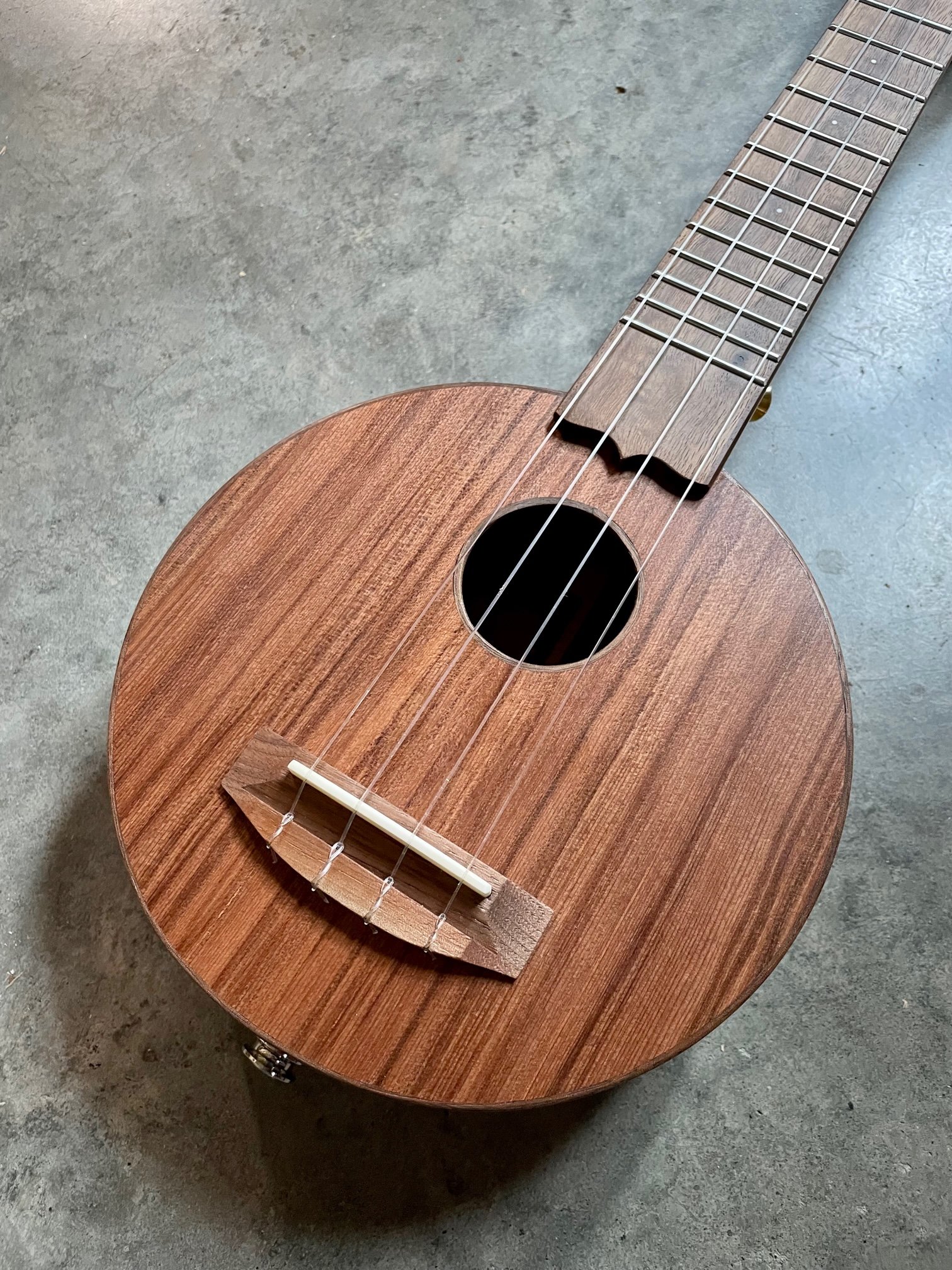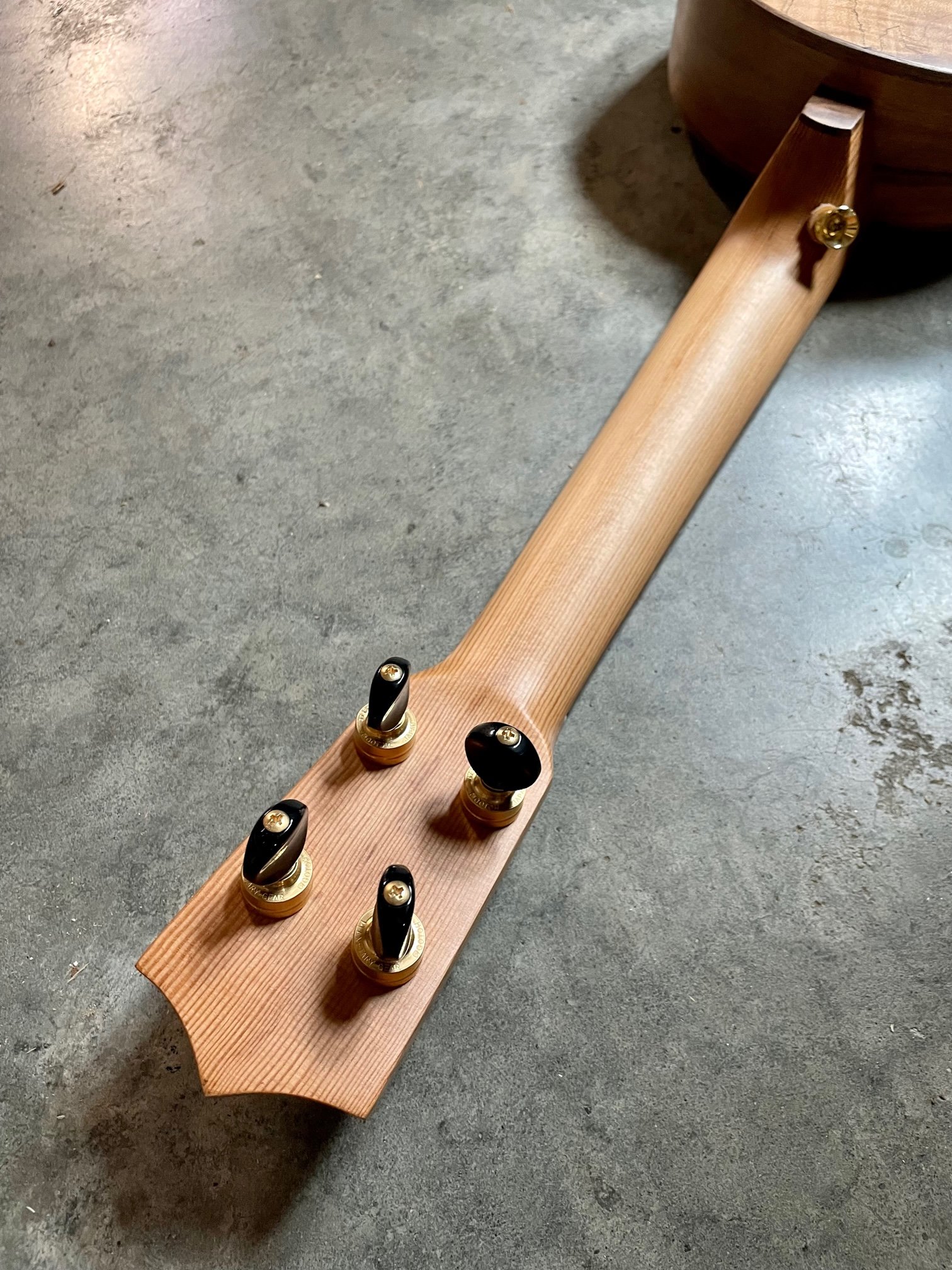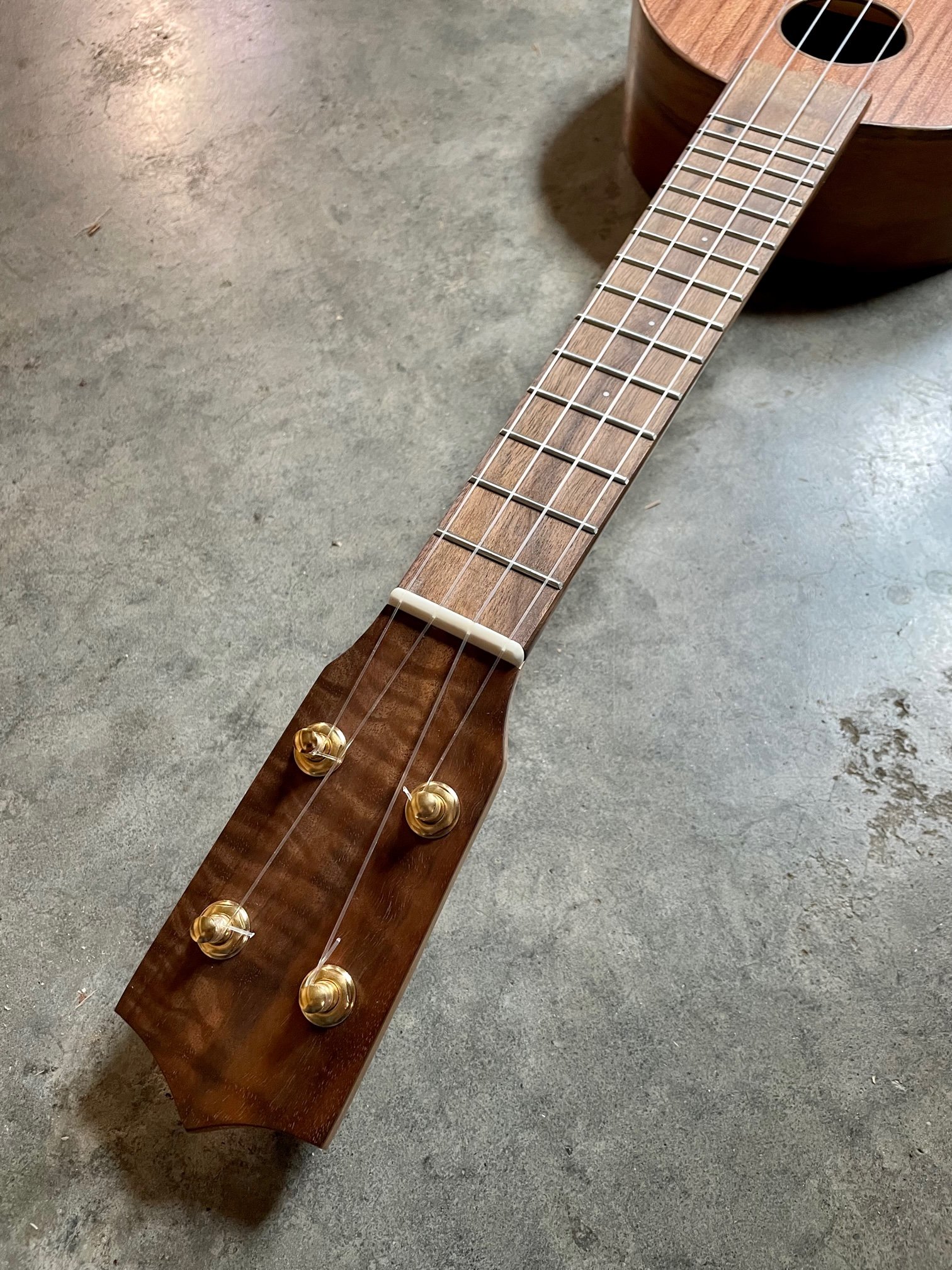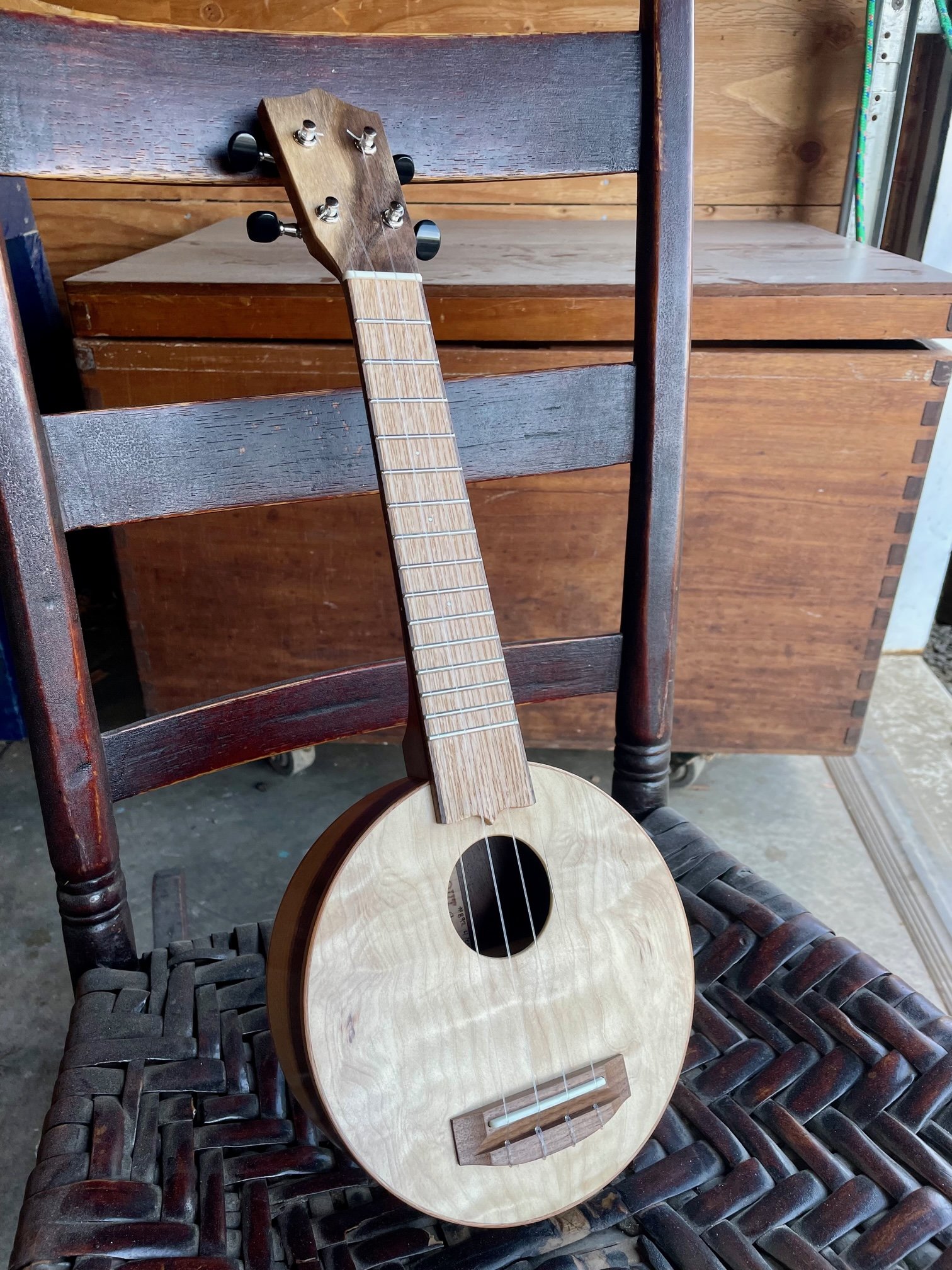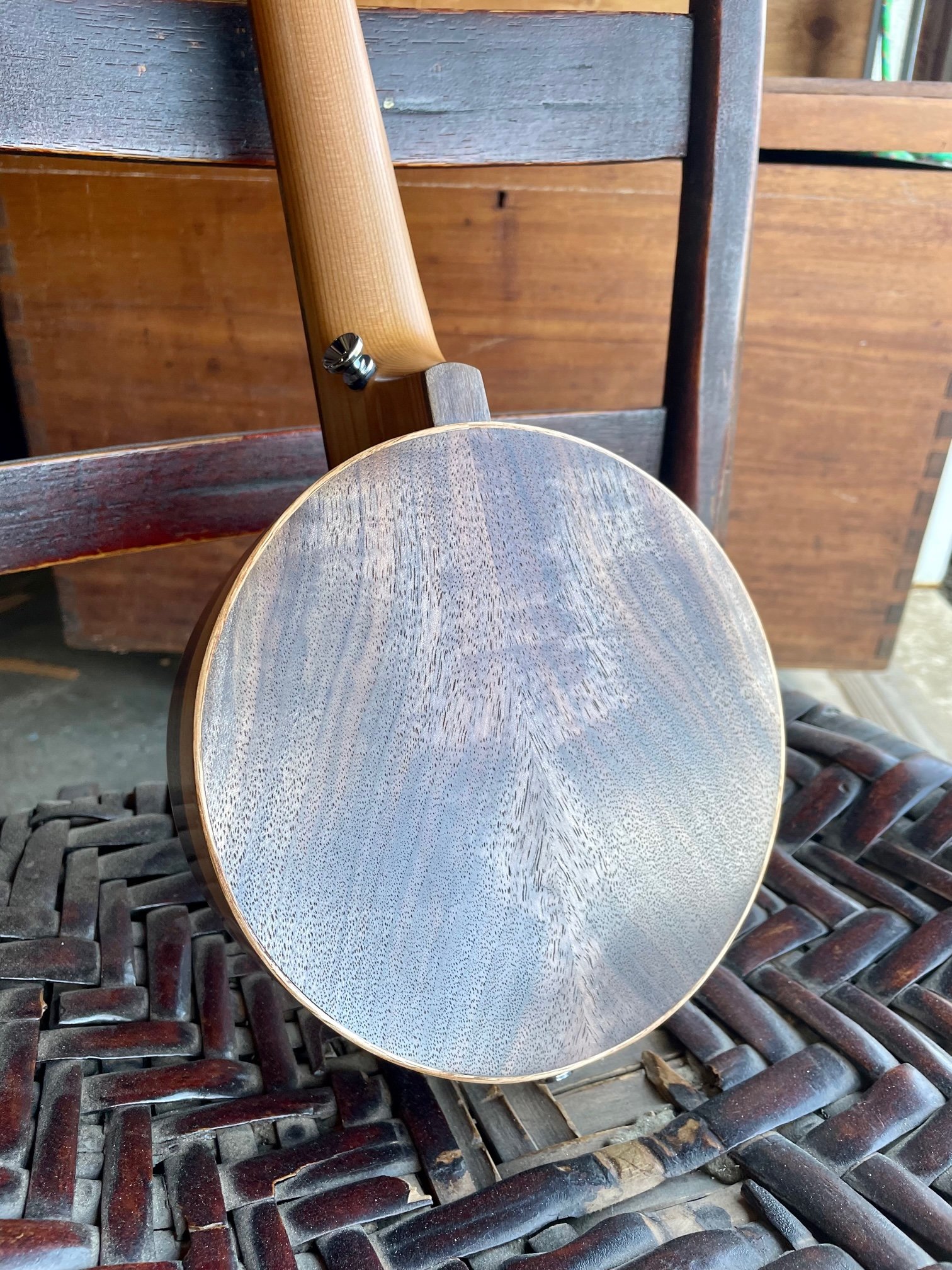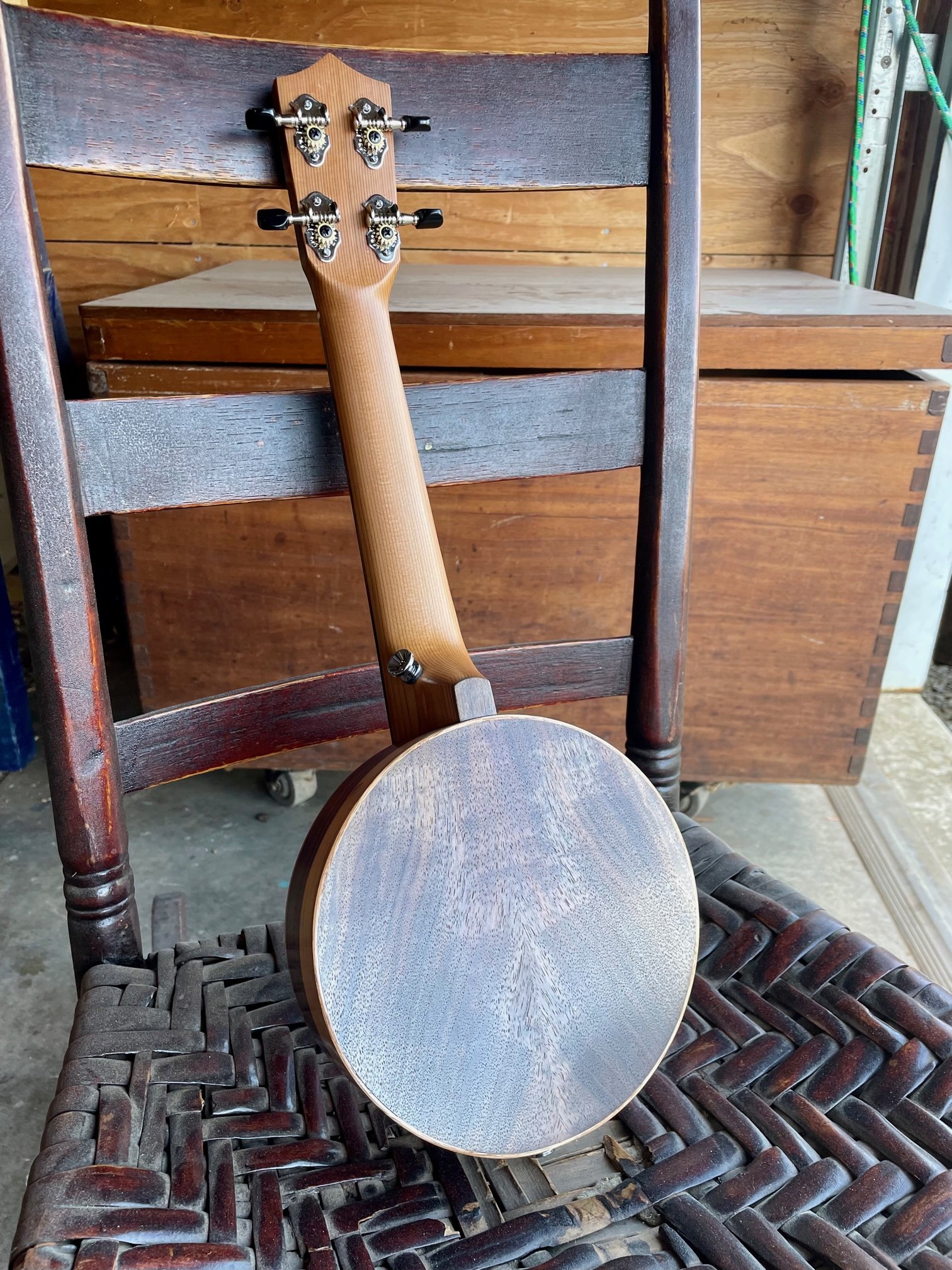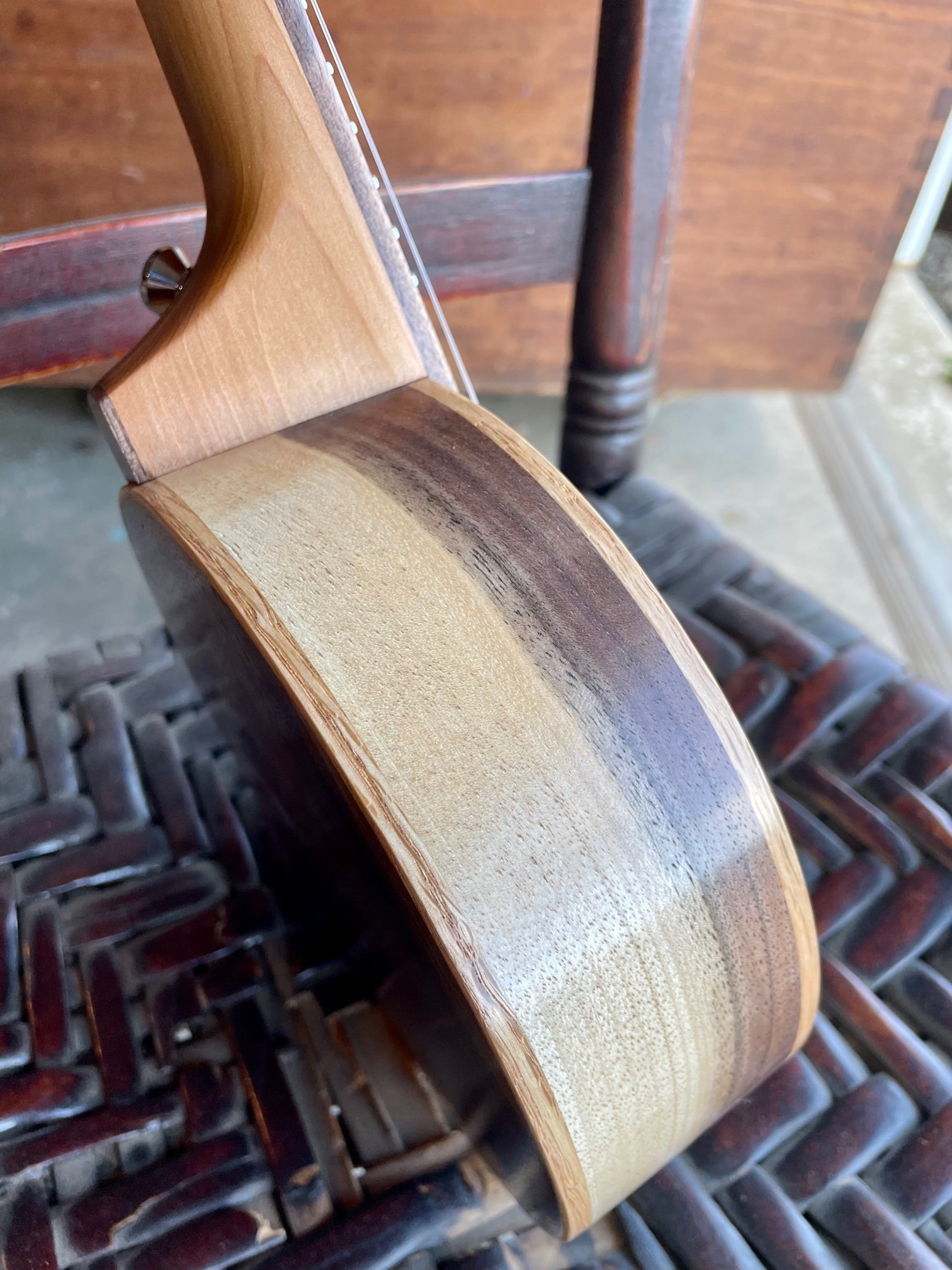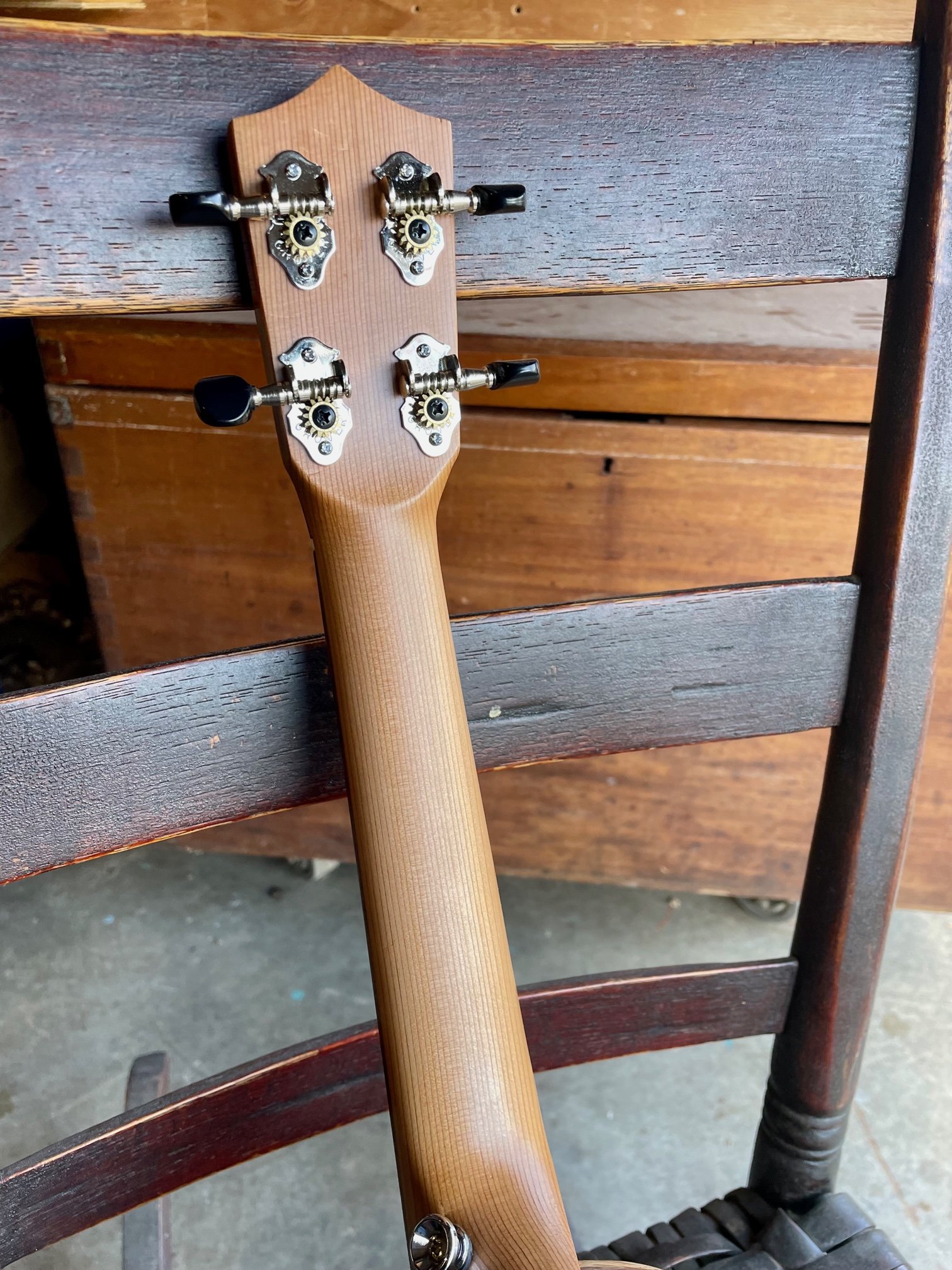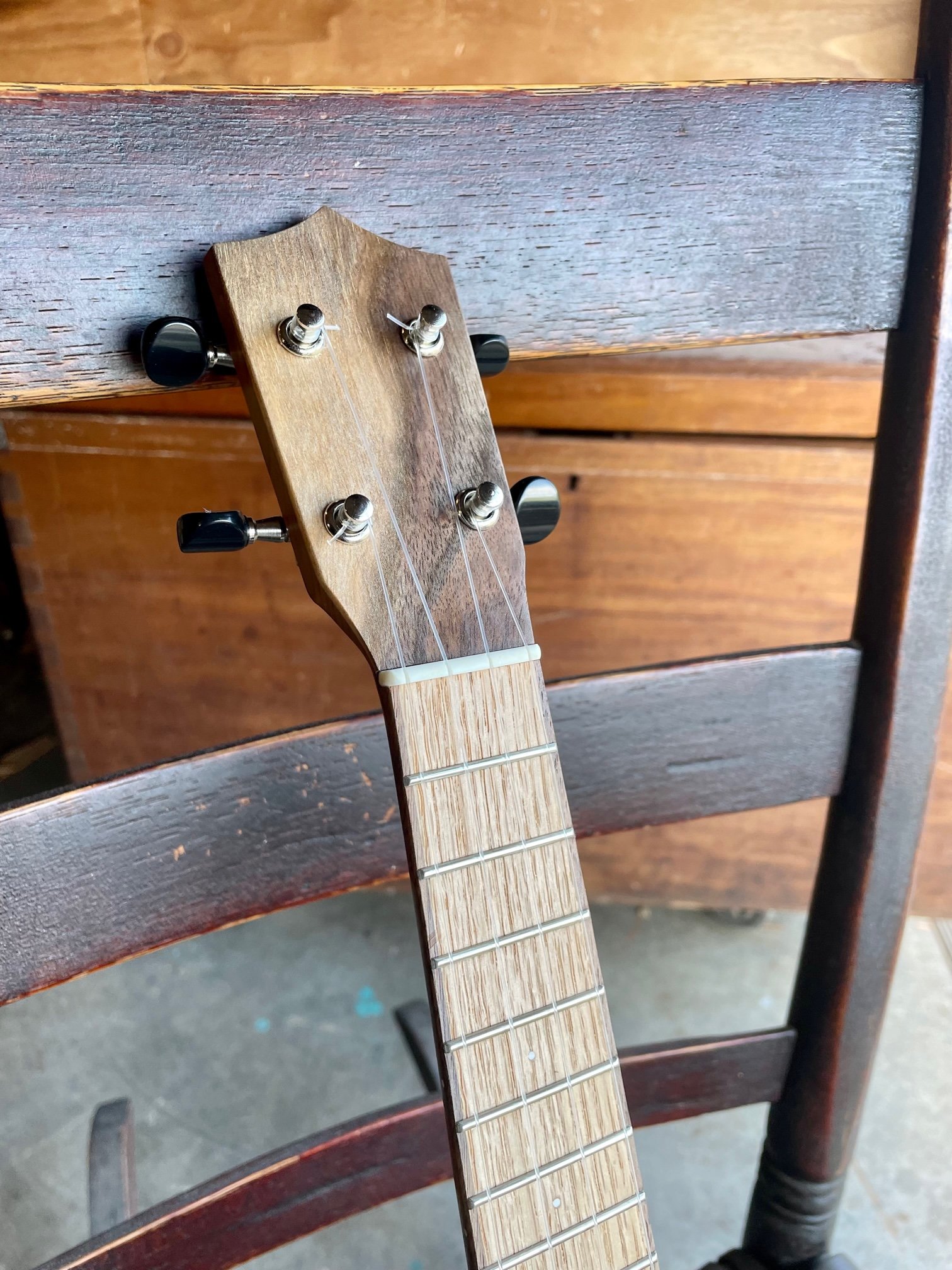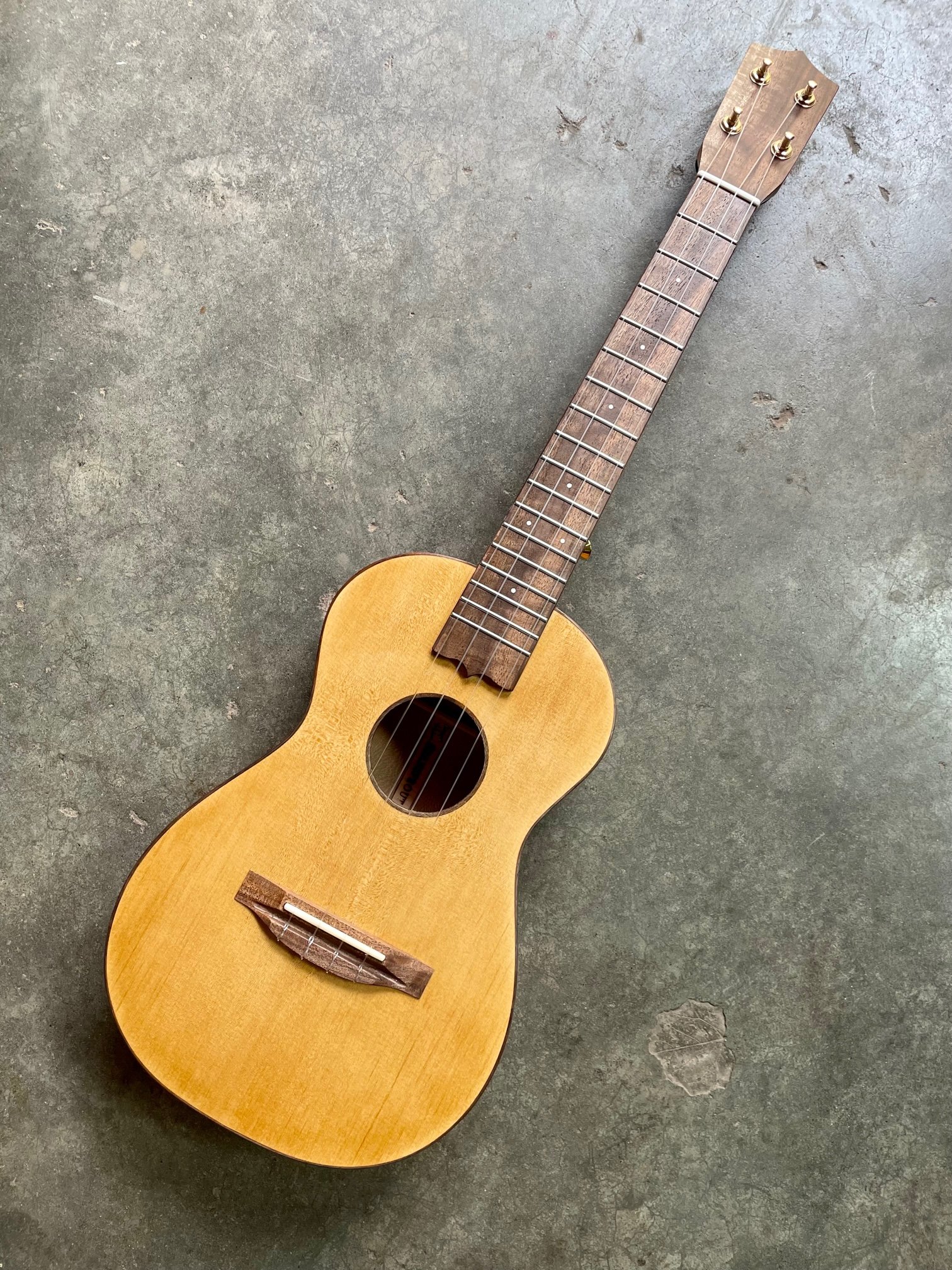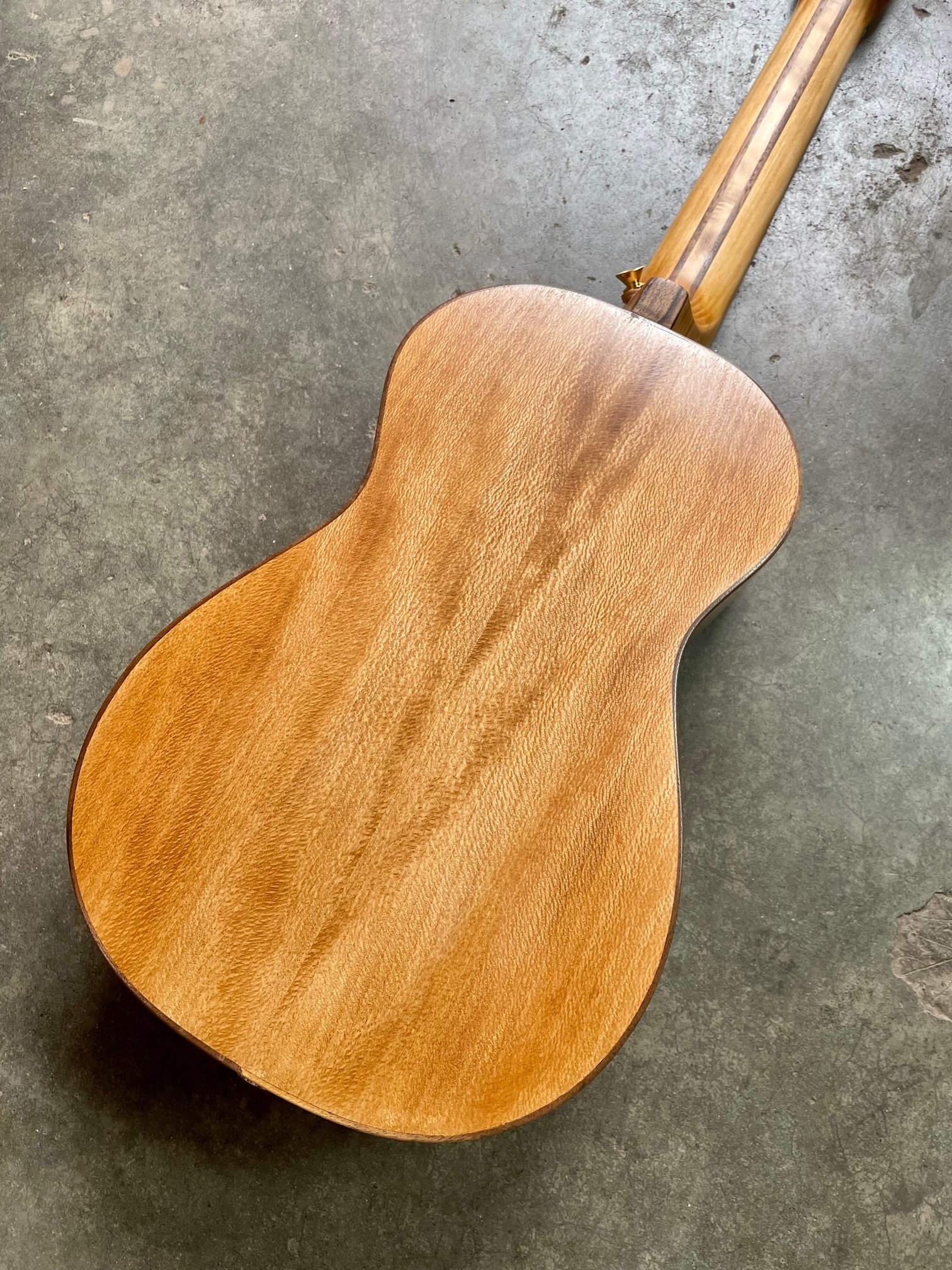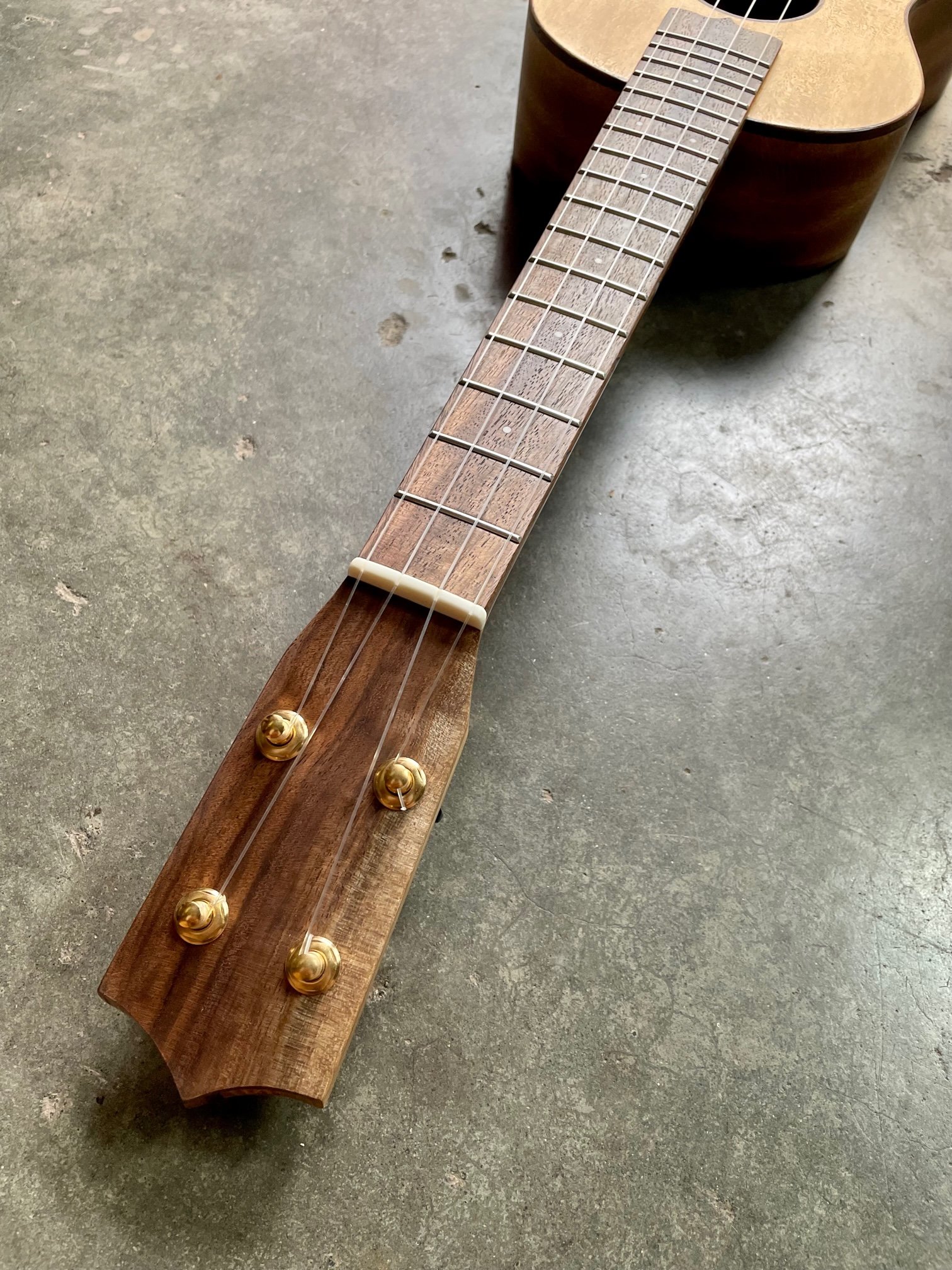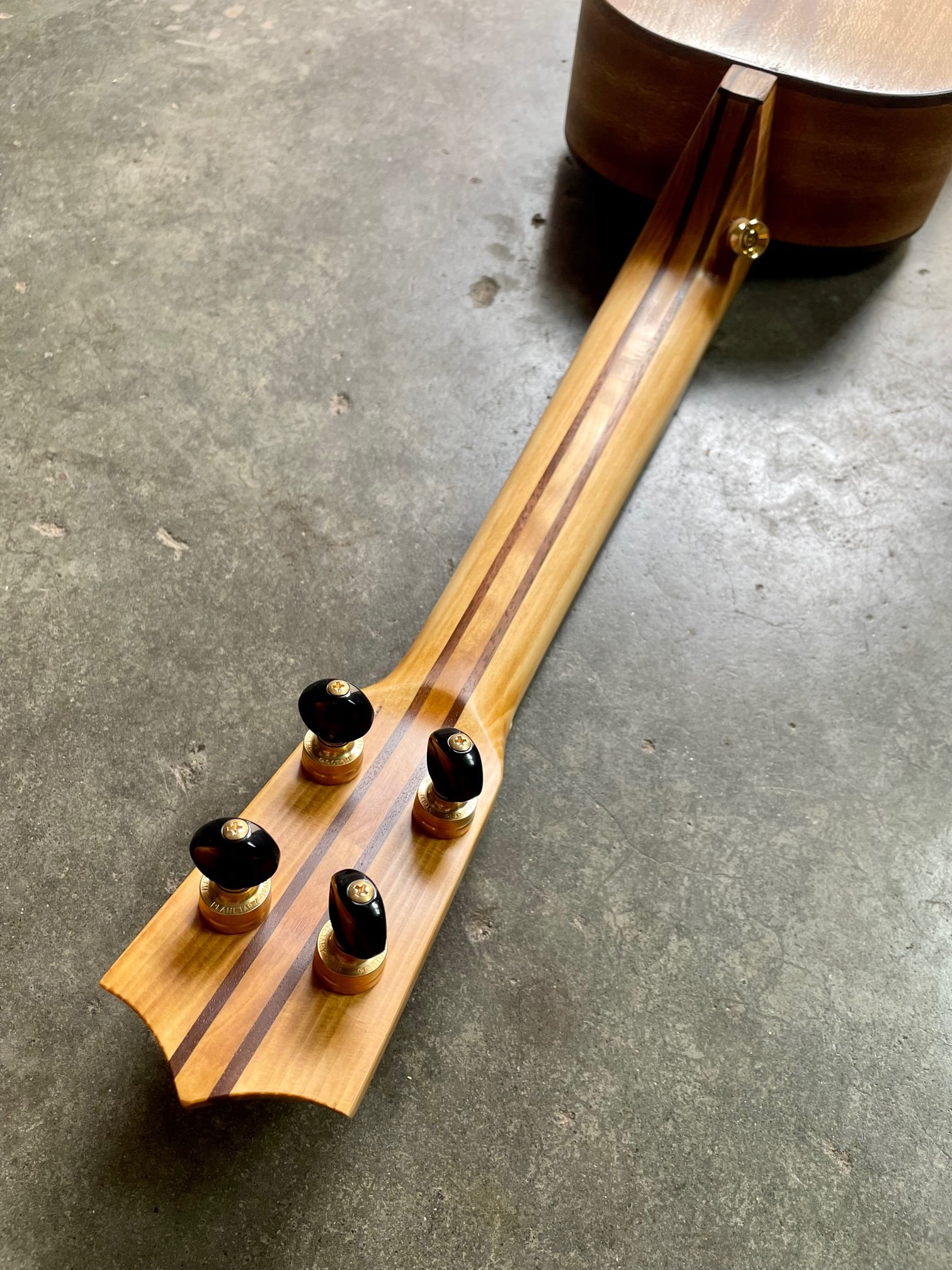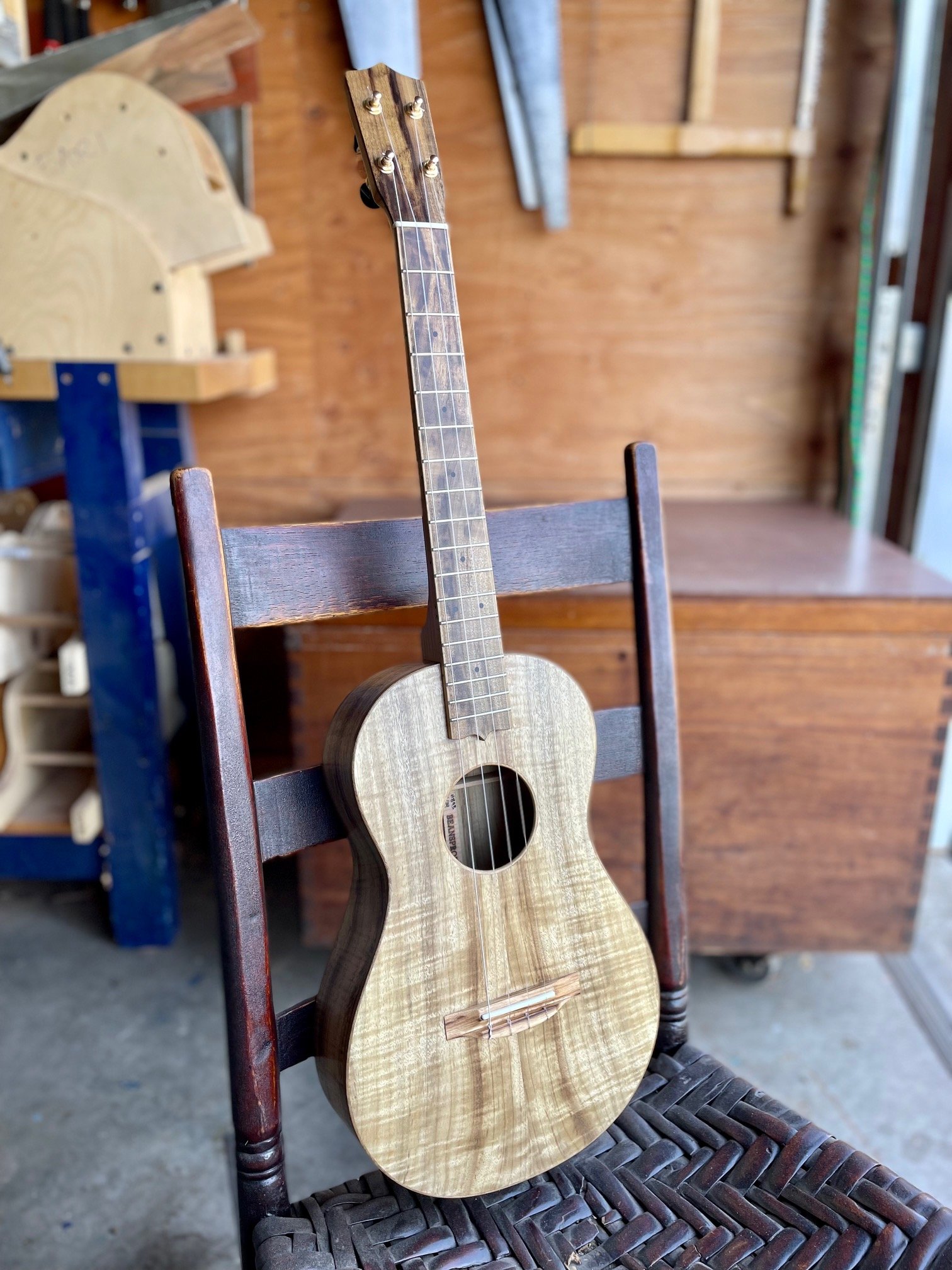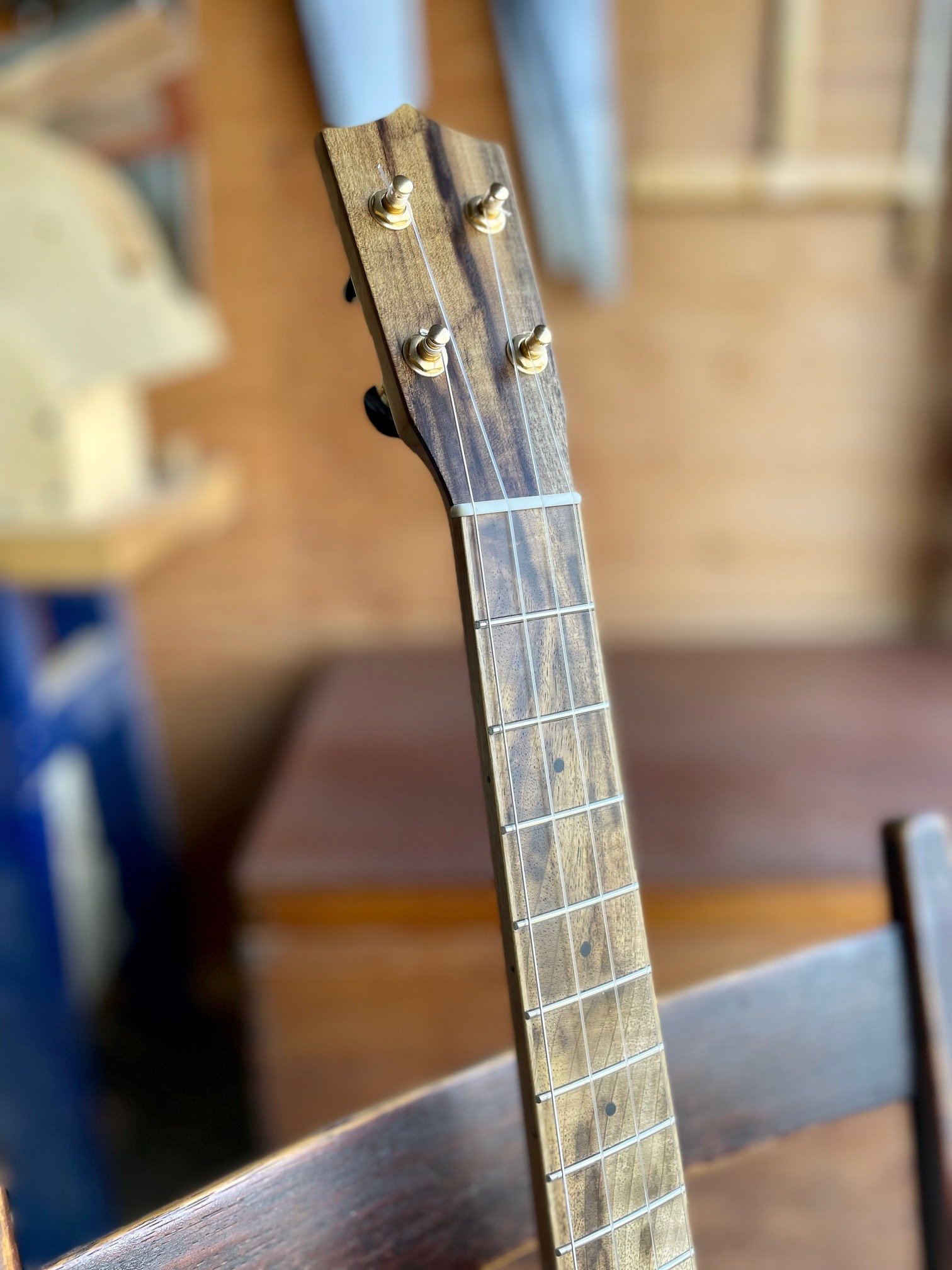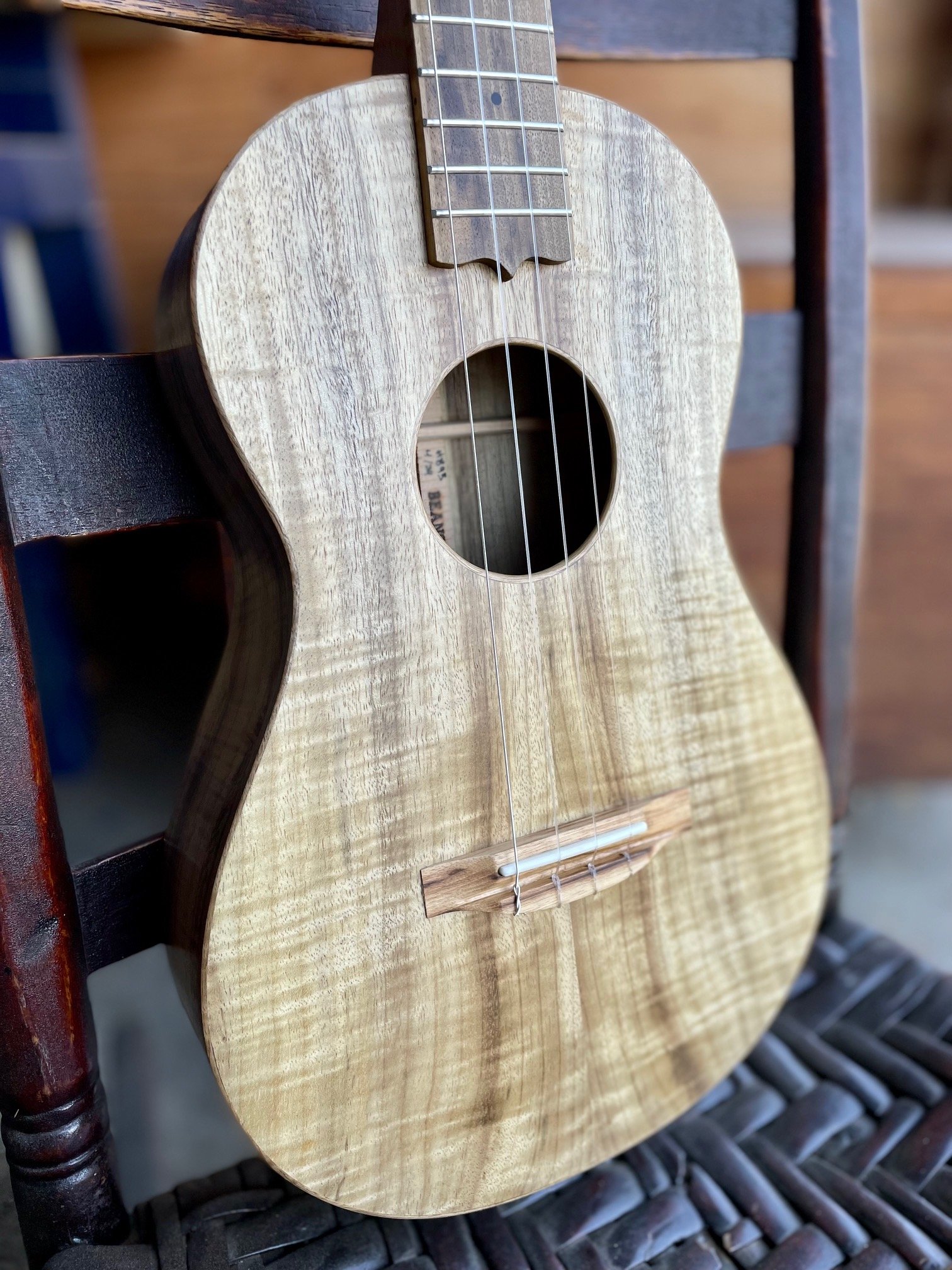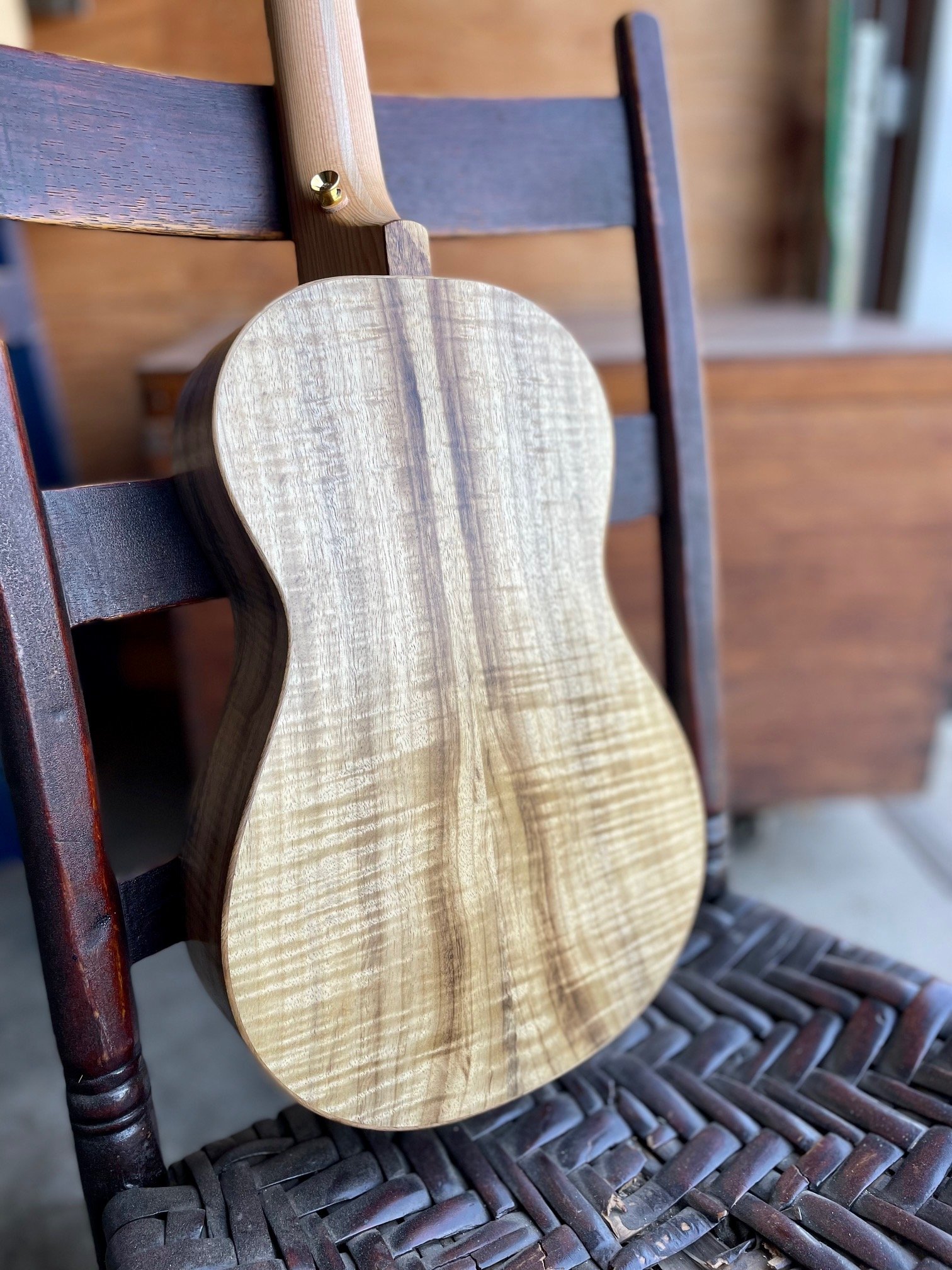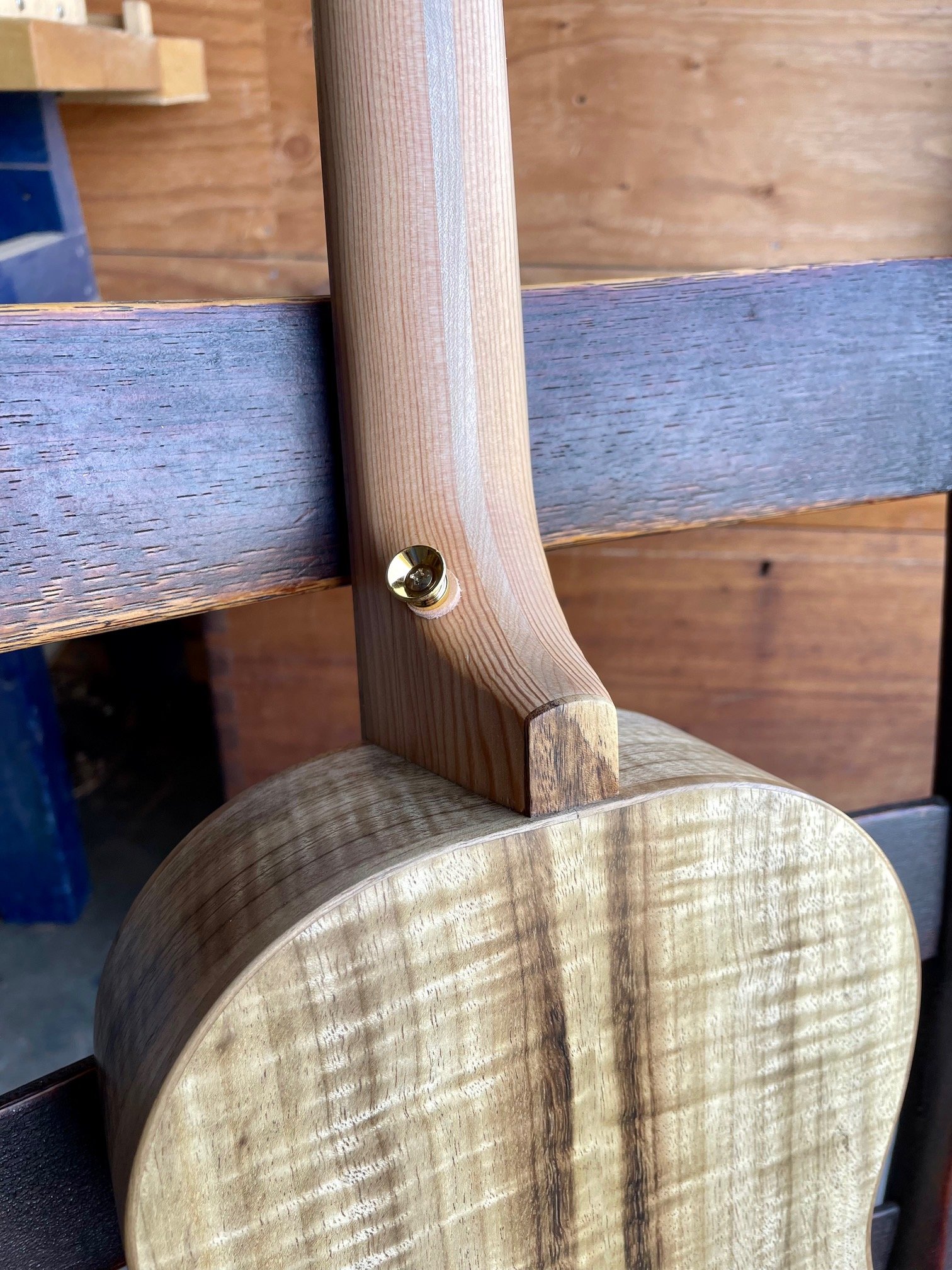I’m really embracing the uniqueness of this tenor guitar design. It sounds a little like a banjo, but also a guitar, a dulcimer and ukulele all at the same time. The ladder braced Spruce is bright and detailed and the curly Oak back and sides reflect the sound well. Luthier Craig Wilson passed on the the Sitka Spruce top to me- it was cut by his father. The curly Red Oak back and sides are from the Carpenter Ant stash in Portland. The Mahogany and Walnut neck is made from scraps from a cabinet shop. The rest is Pistachio from California orchards. Cheers Steve!
#917- Walnut Mosaic Short Scale Banjo
The rim for this banjo is what I call a Mosaic rim, made up of leftover blocks from a few years of banjo building. I bet it has 6-8 different woods in it. The neck is some straight grain Walnut from our friend on Vashon Island and the rest is Pistachio from California orchards. Non steel strings, goat skin head, brass tone ring and a brass arm rest to make it comfortable. A great combination of features for a loud, rich and pleasing sound. The nut width is 1 3/8”, which I find much easier to play than the narrower ones on vintage banjos. Happy plucking!
#916- Cherry, Maple and Pistachio Short Scale Banjo
This customer wanted a lightweight, easily playable banjo with a vintage sound. We chose to use less brass hardware and a short scale neck to lighten it up. The goatskin head and non steel strings helped to get the vibe too. The dark stain, Walnut shell dyed head and patinated brass hardware seal the deal. It has a Maple rim, Cherry neck from the Carpenter Ant stash and Pistachio from California orchards for everything else. Cheers, Sara!
“Hello Aaron and Nicole,
I just got my banjo and I wanted to just say again, thank ya’ll SO MUCH! I swear Aaron you are a wizard. It has such a deep, resonant sound especially for its size. It is so comfortable to play. And your detail work of the tailpiece and the stain finish and the hand dyed head. Really knocked it out of the park. Also, the handwritten note telling me what the banjo is made from and the beautiful hardcase. Perfection, really.
- S. S.”
#913- Mahogany Tenor Guitar
This sort of classic look is my favorite for my tenor guitars. Mahogany with rope binding and a simple Pistachio fretboard does the trick. It has a 21.5” scale length, which is designed for higher tunings, but again we were able to use GDAE with no problems. It has a lot of bass for such a small guitar. The Mahogany is all scraps from a retired cabinet maker. The Pistachio is from California orchards.
#911- Spruce and Maple Baritone Ukulele
When selecting wood for an instrument, I often find one piece that inspires me and then I use it as a starting point for the build. The next pieces start to fall into place as move around the shop in an improvisational way. For this instrument, it was the bug hole Maple I got from luthier Ben Bonham. It has these dark, streaky ant holes that add a lot of character to the blonde Maple. Every other piece of wood supports that choice, either blending into the color palette or offering a bit of contrast. The Spruce top is from British Columbia, salvaged by luthier Craig Wilson’s father. The neck is some Sapele/African Mahogany that I salvaged from a beam. The fretboard/headplate/bridge is Texas Ebony, from a retired banjo builder. The trim is some local Walnut. I think this ukulele sounds bright, clear and precise with easy playability. Cheers Andy!
#910- Redwood and Curly Walnut Baritone Ukulele
Redwood and Walnut is such a great combo. Plenty loud, but dark, rich and warm too. I think the Redwood gives it a little more dry snap than Cedar does. As I play #910, the whole thing jumps around in my lap, vibrating with each note. I am really pleased with it. The Redwood is salvaged from a boat shop in Tacoma. The Curly Walnut is from southern Oregon and the Pistachio is from California orchards, both via woodfromthewest.com. The neck is Sapele, salvaged from a beam. A wider nut and a leaf inlay give it some personality. I have more Redwood and Walnut that matches, drop me a line if you would like to order an instrument like this.
“Hello Aaron & Nicole,
Dropping by here to let you know I received my beautiful baritone ukulele last night. I’m over-the-moon thrilled with the sound and look of it. It’s truly a piece of art and fine craftsmanship that really sings when I play it…so much so that we’ve been inseparable ever since.
Thank you so much for my baritone and all that you and Nicole do!
Yours happily strumming,
- C.S.”
#901- Cedar and Oak Baritone Ukulele
I sold my own baritone ukulele this spring at a music camp and had to build a new one in time to go on tour to England this summer. It has a Cedar top that I milled from a log from Parkdale, OR. I love the grain and color in it. The back and sides are quarter sawn white Oak from the Carpenter Ant stash in Portland. The neck is African Mahogany from a salvaged beam. The rest is local Walnut. I added an over sized rope rosette and a little leaf in the headstock. Just in time for rehearsals!
#909- Juniper and Spalted Maple Tenor Ukulele
I really love a project where we get to celebrate the wild and natural features of real trees. A little bit of rot, a nice knot, some compression curl or a unique texture are all reminders that you are holding a handmade object made from natural materials. This Juniper top is from eastern Oregon from our friend Chris at Yodel Boy Woodworks. The spalted Maple back and sides are from Libby near Anacortes, WA. The Fir neck is salvaged from an old house. The rest is local Walnut that I milled. It has a low g, a little bird’s foot purfling and an inlaid and wood burned sun in the headstock. A real pleasure, I can’t wait for Jen to come pick it up!
“Dear Aaron and Nicole,
What a gift it was to go and pick up my new ukulele in person. To get to see where all the magic takes place and witness the depth of intention, creativity, passion, and mastery just adds to the beauty I see and the joy I feel when I play my sunny new ukulele. It has such a light and sweet tone, plays so easily, and sounds so clear and resonant – I’m completely smitten.
- J. B. ”
#903- Figured Koa Tenor Guitar
I have used Mahogany for a few tenor guitars now and have been wanting to make a Koa one. I remember a vintage Weissenborn Koa tenor guitar that I saw some photos of, which inspired me to make this one. The Koa for this project is all Clockmaker’s Koa from the Carpenter Ant stash in Portland. I didn’t expect it to be so fancy, but it did not disappoint. It has a few bug holes and bark inclusions in the sapwood that I filled, reminding us of its life as a tree. The rest of the instrument is curly Maple, which is a good partner for the sapwood. It has steel strings and is tuned DGBE with a sweet and direct tone. It has ladder bracing and responds to the lightest touch. I am very proud of it. As with all my Koa instruments, I will donate to plant more Koa trees here.
#904- Cherry and Texas Ebony Short Scale Five String Banjo
This is for our good friend Marianne, who has been playing ukulele for many years, but has recently been studying the banjo. We tried a larger banjo for her a few years ago but it didn’t stick. She recently played one of my short scale banjos and she was sold! The main wood is Cherry, salvaged from the Carpenter Ant stash in Portland. The second wood is Texas Ebony, which I bought from a retired banjo builder. The 11” Cherry rim has no metal tong ring, which makes for a lighter banjo and a woody sound. She added a goat skin head for an earthy tone and a brass arm rest for comfort. The vintage Hawaiian shaped headstock was a good choice for the custom inlay. Thanks for all of your support, Marianne!
#907- Spruce and Cherry Tenor Ukulele
I think that my instruments fill an important niche. They are loud enough to get along with other instrument at a jam session like guitars and banjos, but still have rich tone and long sustain. I think it might be because of my many years of playing in string bands and acoustic jams where I want to be heard but not be obnoxious (even though I like banjo ukes!). This combo of Spruce and Cherry is just the thing. The top and back panels are one solid piece instead of the more common book match. It’s hard to find wide enough boards for this, but I have a stash, of course. The Spruce is from British Columbia, harvested as a drift log by luthier Craig Wilson’s dad. The back and sides are from the Carpenter Ant stash in Portland. The salvaged Fir neck is from old floor joists. All the Walnut trim is from a local tree that I milled. The dark Pistachio fretboard/headplate/bridge are from California orchards. It has a K&K pickup and a low g, ready for fun!
#905- Koa and Pistachio Mini Five String Banjo
Banjos are typicallyt made from domestic hardwoods like Maple and Walnut, however, I have made a few from Koa now and I am really pleased with them. I’m lucky to have some flat and rift sawn Koa boards that were imported in the 1960’s for making clock cases. They wouldn’t work to resaw for ukuleles, but they are great for banjos. Koa makes a sweeter and softer sound than maple and I hope I get to make more like this. The Pistachio fretboard and trim makes a nice contrast and comes from California orchards. This has an arm rest and a pickup added, tuned to open g. Cheers!
“I received 905 and it is simply amazing! Thank you so much for making this work of art.
- D. M. ”
#906- Mesquite, Texas Ebony and Mosaic Mini Five String Banjo
Every time I make a banjo rim, I save the extra rim segments so that I can eventually combine them all to make what I call a mosaic rim. I think this one has 6-7 different kinds of wood in it. I paired this rim with a Mesquite and Texas Ebony neck, both of which are domestic hardwoods that I got from a retired builder. It has a goat skin head, brass arm rest and is tuned to open G with non-steel strings. It’s a vibrant and charming little banjo. This instrument is a very special present from a father to his daughter who is about to turn 11. Happy Birthday T !
#902- Redwood and Spalted Maple Alto Ukulele
Diane asked for a ukulele that looked and sounded like autumn. To me, that means dark, rich, comfortable but with a hint of a chill. I chose Redwood from the top, salvaged from a driftwood log. The spalted Maple back and sides are from our friend Libby’s land near Anacortes, WA. The spalting is the start of a fungus, changing the wood back into compost. The trick is to catch it and dry it out before the wood becomes unstable. For the fretboard/headplate/bridge, I chose some Ambrosia Maple, which has bug holes from a beetle that causes the tree to make rainbow streaks through the wood. Im happy with how it turned out, with easy playability and a complex tone. Thanks Diane!
“Aaron and Nicole,
Just a note to let you know, the new Queen 👑 has arrived safely from her cross-country journey with UPS. Light, smooth and silky to the touch, that new wood scent, striking fall colors that delight the eye - “the beauty of rot and decay” as eloquently described by Aaron. A clear, mature voice, sweetly lingering on each note… Bug holes! Love it all!
The whole process of ordering, choosing woods, updates, has been a delightful experience.
Thank you so much!
- D. G. ”
#894- Monterey Cypress Tenor Ukulele
I love finding new domestic woods! In this case, I found some Monterey Cypress that I got in trade from another builder. It is from Monterey Bay California, of course. This is a soft wood that seems almost as stiff as spruce, but has a glassy quality that led me to choose it for the back and sides as well. This isn’t without precedent, as Cypress is used for back and sides in Spain. I bound it in Walnut for some contrast and chose Dogwood for the rest from the Carpenter Ant stash in Portland. It is light, cheerful and sweet and I’m darn proud of it.
#898- Curly Cherry and Pistachio Five String Banjo
I think Cherry is a great banjo wood, confidently placed between Walnut and Maple. Plenty loud, but a little sweet, with a growl to the low string. This one has a goat skin head, brass tone ring, arm rest, Pistachio trim and a little sprout inlay on the headstock. The Cherry comes from the Carpenter Ant stash in Portland and the Pistachio comes from California orchards.
“Good evening, Aaron and Nicole,
Just wanted to tell you that I’ve been playing #898 a lot. Aside from its visual beauty and lovely tone, it’s the most comfortable banjo I’ve ever played, and has proven to be a huge hit around here. Everyone who has seen or heard it has been vocally (and as nearly as I can tell, sincerely) impressed.
In short, I love it.
All the best,
- J. L. ”
#896- Redwood and Dogwood Scout Ukulele
Dogwood is a multicolored hardwood that we see quite a bit in the NW, but it rarely gets big enough for woodworking. This Dogwood back and sides came from a tree at our friend Lizann’s house which her father milled many years ago. It pairs perfectly with the striped Redwood, which is the scrap left from a guitar top. The neck is some salvaged Douglas Fir and the rest is local Walnut. It is sweet and dusty, a joy to play. Thanks Jason!!!
#892- Port Orford Cedar and Walnut Scout Ukulele
I make these Scout ukuleles when I have the extra time, from scrap wood from other projects. Basically I have a couple of bins of suitable materials that I choose from, letting each piece lead me to the next. For this uke, my son Henry chose everything. Curly Port Orford Cedar top, Walnut back/sides/headplate/bridge, Red Cedar neck, Oak fretboard and body binding. I tried out some little, nickel Grover geared tuners and matched them to some nickel strap buttons. They are lightweight, work great and suit the price point for this little uke. It is bright and cheerful, with a surprising amount of sustain.
To join our scout waiting list, please email Nicole at info@thebeansprout.com
“Hello Keims!
The little Scout has arrived! And I absolutely love it. The woods are truly beautiful - the colors, the grains, the trims. Such a lovely choice of woods, Henry. The tone is sweet, bright and full. Aaron, it is truly a delight to have this little ukulele. And a pleasure to support your endeavors. And I love that it is built from scraps in your shop. Here’s a little video of me playing a little tune I wrote — “Zoe’s Shuffle” (for our cat, Zoe).
Many thanks and all the best to you, Nicole and Henry.
What a great gig bag too!
- P. S.
”
#897- Yellow Cedar and Sycamore Tenor Ukulele
This instrument is a tenor version of an alto ukulele that I already built for this customer. It sounds full and bright, with a springtime cheerfulness that feels good today. The Sycamore back and sides are from the Carpenter Ant stash in Portland. The yellow Cedar top and the Port Orford Cedar neck came from my neighbor, a retired flute maker. It is tied together with local Walnut fretboard, headplate, bridge and binding. The customer requested an amber tint to everything, which makes it look old and a little rustic. I appreciate every customer, but repeat customers always make me feel extra thankful. Thanks for keeping the lights on, Don!
“Dear Aaron and Nicole,
The beautiful sycamore, Alaska cedar, walnut, and Port Orford Cedar/walnut neck #897 was delivered today. I could not be more pleased with its appearance and its out of the box tone. You did a wonderful job blending the tinting of the exceptionally tightly grained sycamore back and sides with the old and figured Alaska cedar and Port Orford neck.
Thank you for the elegant walnut face plate and for carefully matching the arc of the walnut figuring in the fretboard with the sweep of the grain in the cedar.
What great tone this tenor has all the way up and down the fretboard! It’s easy to play with a light touch, with warm mid tones and deeper bass resonance on the C string with only a little more pressure. The sustain is loooonnnng! And there are overtones as a bonus.
You’ve made another singing Beansprout ukulele, Aaron, and I look forward to playing it for years to come.
Best regards,
D. H.
”
#895- Mastergrade Myrtle Baritone Ukulele
All Myrtle instruments are always a favorite of ours. It feels like our Koa, as it comes from Oregon. This particular mastergrade set came from luthier Jayson Bowerman, as it was too small to use for his guitars. It also has Myrtle binding, fretboard, headplate and bridge! The neck is salvaged fir, with some evidence of its past life as a floor joist. It is strung gcea, which is a fresh sound when you are expecting the more common dgbe range. It has a 1.5” nut width and a K&K pickup as well. It’s off to a repeat customer. Cheers Tom!







































































































